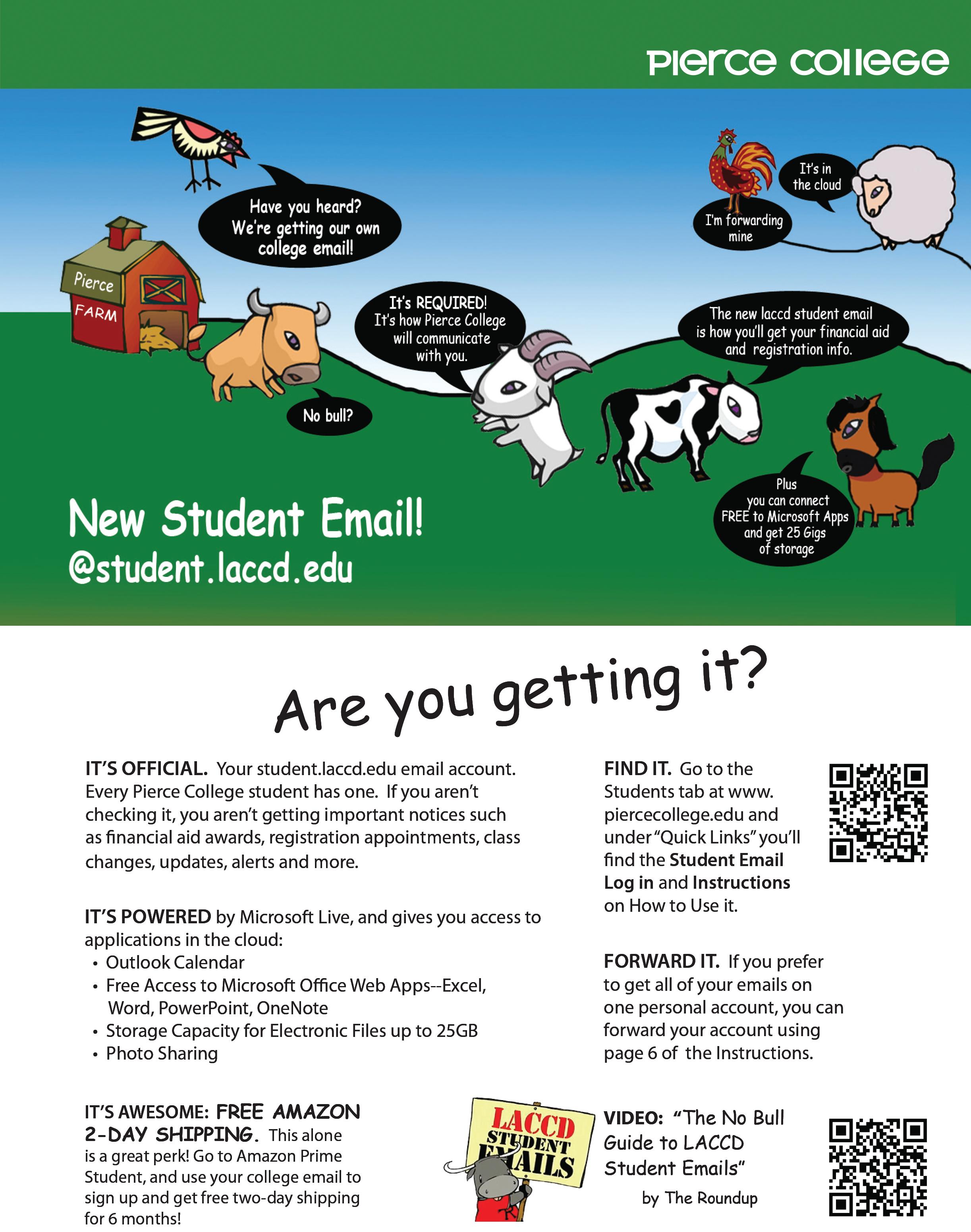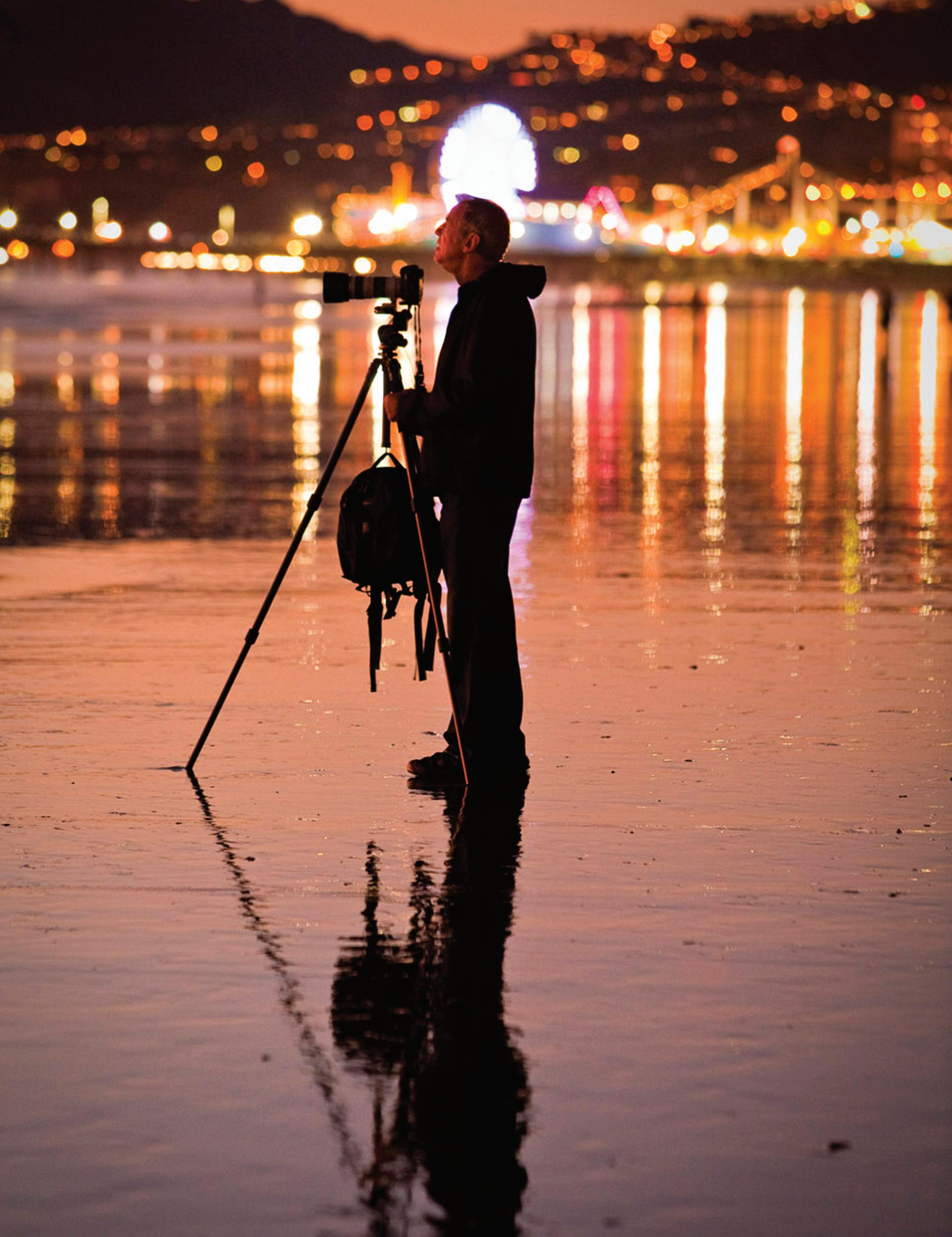The Bull
The babysitters of the FUTURE No Kill L.A. Saving lives one pet at a time
3themed eateries in the L.A. area


The babysitters of the FUTURE No Kill L.A. Saving lives one pet at a time
3themed eateries in the L.A. area

Everyone must eventually overcome obstacles that life throws their way. This Fall, The Bull Magazine is a standing tribute to those who beat the odds and persevered through tough circumstances. Writers bring stories to the page that speak of an indomitable spirit, characterized by this issue’s theme: Resilience.
Even in the darkest hours, hope can stay alive where someone struggles for their goals against adversity.
Anyone and anything alive today could be said to be resilient, and in the pages of this magazine readers can read stories about those who managed to find inner strength. Sometimes the path leads to stardom, other times it might just be a new home, and for some it may be acceptance.
Throughout the journey of publication the staff of The Bull Magazine has done more than just show how specific individuals are resilient; they have shown themselves to be resilient as well.
In the end the ubiquity of the collective struggle of all creatures to coexist and thrive has been portrayed in this issue of The Bull. Please remember that anything is possible when good people work together, and enjoy.

Jeremy Nation
Managing Editor
Lynn Levitt
Design Editor
Calvin Alagot
Photo Editor
Monica Salazar
Copy Editor
Michaia Hernandez
Writers
Maddie Bernie
Angel Bocanegra
Josee Cantabrana
Connor Cook
Alvaro Gomez
Jeffrey Gonzalez
Kashish Nizami
Jonathan Pineda
Evelia Rodriguez
Raymond C. Rodriguez
Lital Shoshan
Marielle Stober
Ashley Walton
Photographers
Mohammad Djauhari
Silvik Hagopian
Danielle Moor
Lisa Richardson
Advisers
Jill Connelly
Jeff Favre
Illustrator

Lauren Vellvé
Julie Bailey
Jasson Bautista
Stefanie Frith
Sean McDonald
Todd Rosenblatt
 Jeremy Nation
Editor-in-Chief
Front Cover Photo and Portrait: Monica Salazar Back Cover Photo: Lynn Levitt Staff
Photo: Mohammad Djauhari
Jeremy Nation
Editor-in-Chief
Front Cover Photo and Portrait: Monica Salazar Back Cover Photo: Lynn Levitt Staff
Photo: Mohammad Djauhari










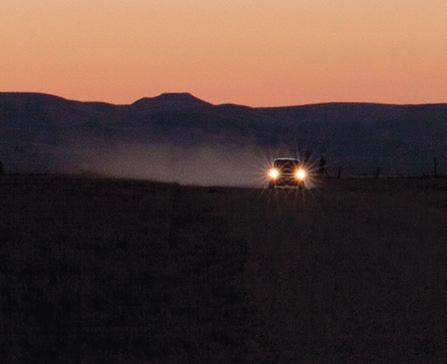
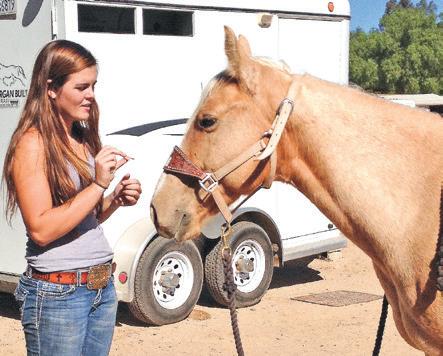

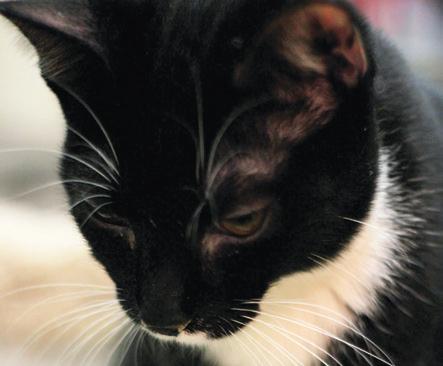
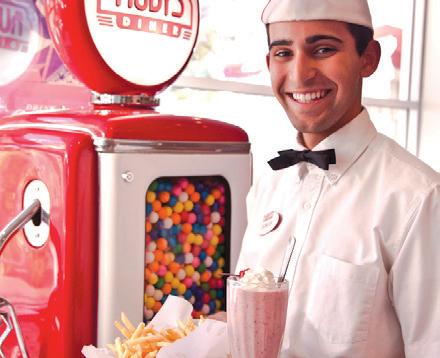

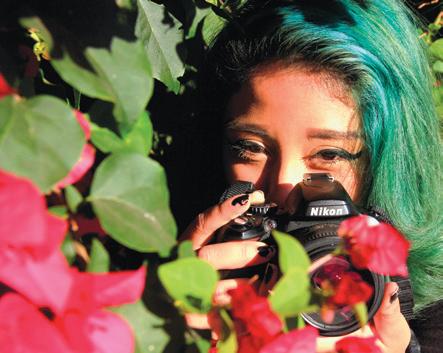

Wriggling her toes to remove a strand of seaweed, a 20-year-old girl looks out toward the emerald-tinted ocean. Determined to catch a wave, she studies the ocean for a few moments with her left hand shielding her eyes from the beaming sun, before resolving with one swift nod that this time she’s going to do it.
She raises her right arm slightly, allowing the crutch underneath it to fall, and then grabs the surfboard buried in the sand beside her. Her 14-year-old sister offers her shoulder for support and they hobble for 10 minutes to the cold water. Smiling, sweat beaded above her brow, she drops the board into the water and swims out before slowly raising her left leg to try to stand up. After a few seconds of standing, her leg gives out, and she crashes into the ocean. Upon losing sight of her, panic spreads across the faces of the beach-goers who had been staring at the unusual sight, but her sister remains surprisingly calm. Her sister treads water fast enough for them to exchange a high-five after she erupts out of the waves with a fist in the air.
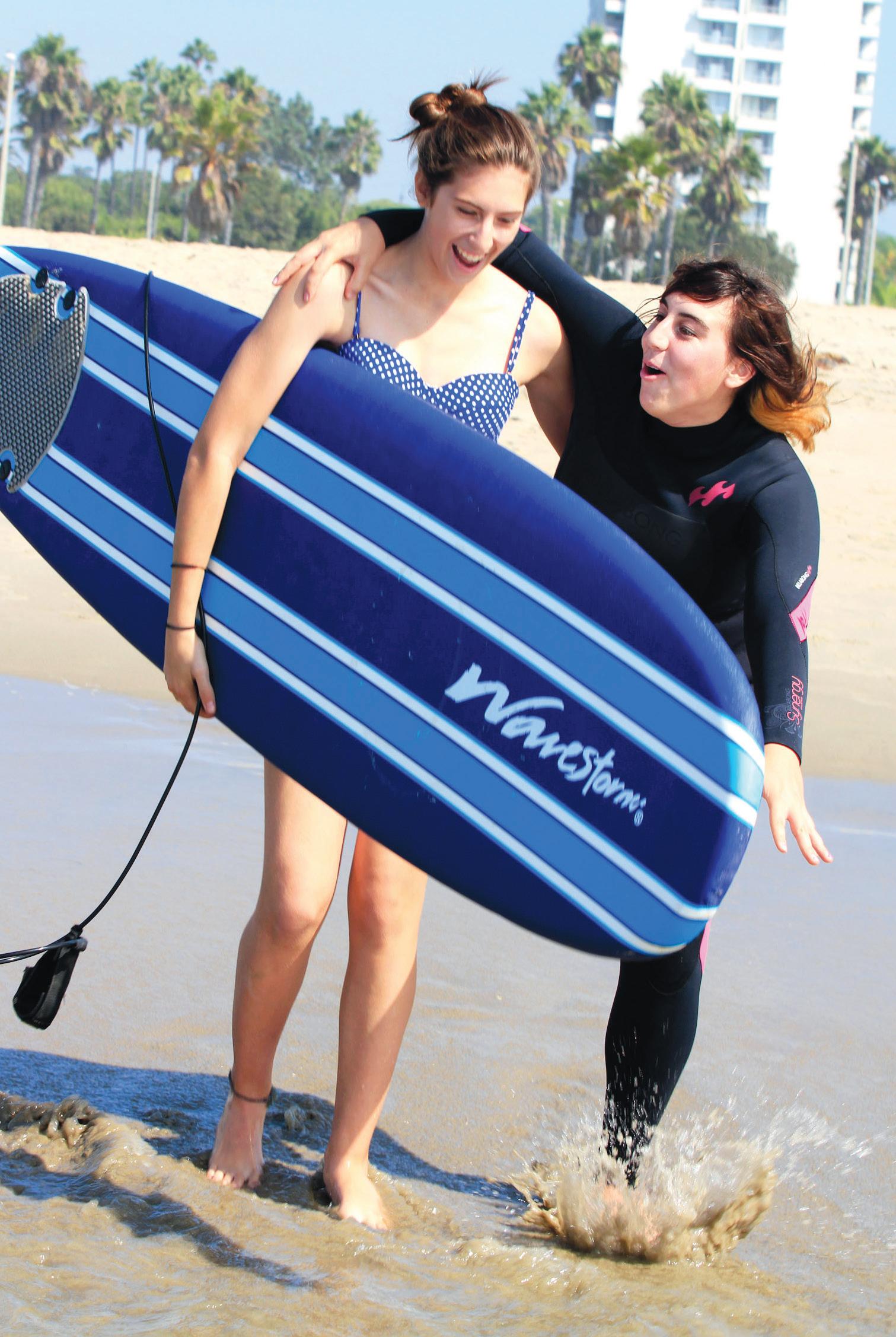
Lyndsay Lucas doesn’t describe herself as most amputees might. The confident and vivacious theater and performing arts major spends most of her time with her friends. She likes to bowl, swim, surf, rock climb, kayak and work backstage for theater.
When someone asks about her missing right leg, she likes to say that it got bitten off by a shark or that she’s slowly turning into a mermaid. Ask, and she’ll tell you as she taps the thigh connected to a prosthetic leg that her biggest struggle in life is her dyslexia.
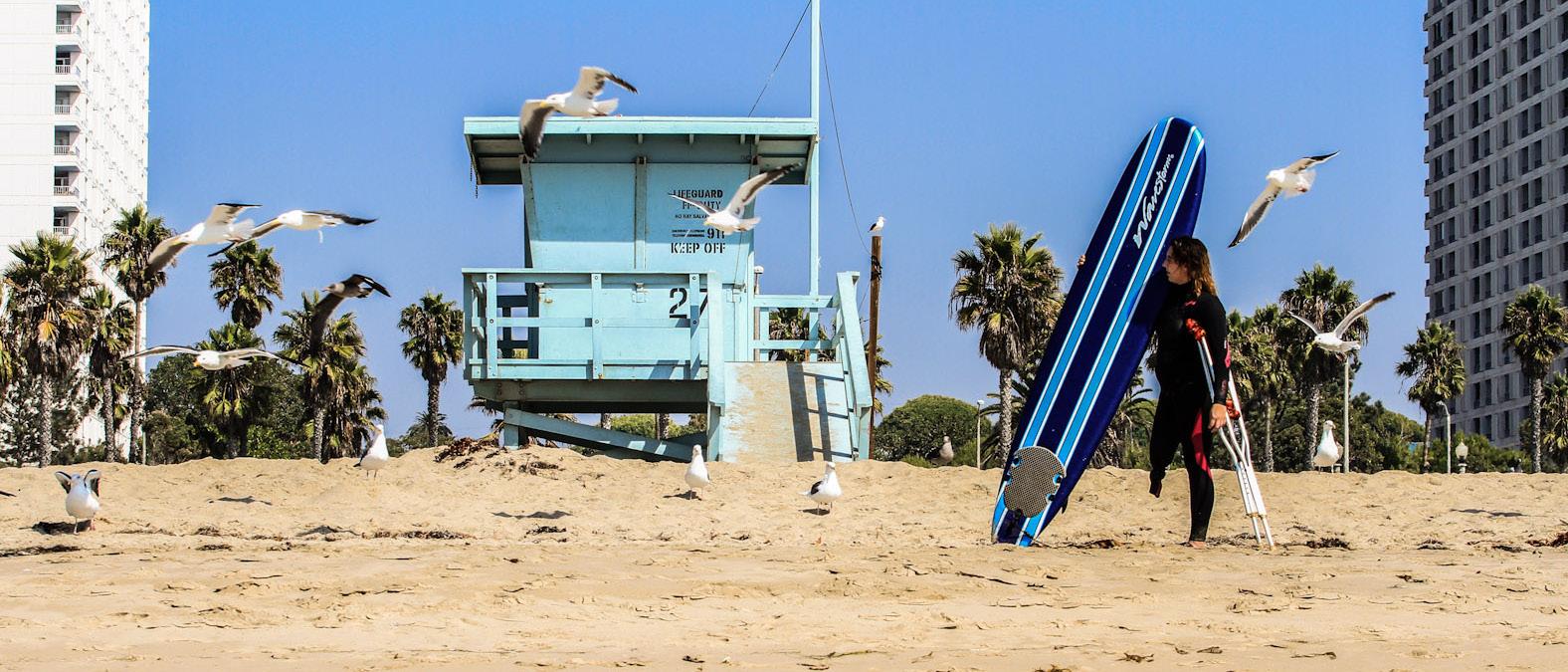
Lyndsay was just 12 years old when she began to experience pain in her right knee. It had swelled up, and it hurt to walk. Her parents assumed it was because she was overactive; she loved to vigorously play sports and climb trees, and was frequently injured.
It was May 2005 when her pain had begun, and when it still hadn’t subsided by August, her parents suspected that something was wrong. Still, she went to visit her aunt in Yucaipa, and one day they were leisurely walking to a Rite-Aid Pharmacy. That’s when her leg gave out from under her, and she fell onto the parking lot’s rough pavement. Lyndsay’s aunt called her parents and told them that she needed to go to a doctor as soon as possible.
Lyndsay went to a doctor, to get an X-ray of her knee, and the next day she received the news that the results did not look good. After visiting a specialist, she and her mother, Ariadne, were told that they
Sisters Lyndsay and Emily Lucas are shocked when the cold Santa Monica water rushes over their feet. Story by: Kashish Nizami Photos by: Monica SalazarShe lost her leg at 12, but not her attitude
needed to go somewhere that would have the resources to help her, and they were directed to Cedars-Sinai. There she was scheduled for a bone biopsy, where a sample of bone was to be taken from her kneecap, and then she was supposed to go home.
After a few hours, however, Ariadne was told that that would not be the case. Instead, her daughter was to be admitted to the hospital immediately. After meeting with many different doctors she was diagnosed with osteosarcoma, a common type of cancer that develops from certain tissues from the bone, in her right kneecap.
“When I found out, I was just beating myself up to no end. ‘Why didn’t I take her in sooner? Why didn’t I take her right when she was saying it hurt,” Ariadne said. “The guilt… They say it’s normal, but as a parent it’s still stuck in your head.”
Doctors were quick to recommend treatment, and it was established that Lyndsay would receive chemotherapy. Although it was a dangerous treatment to receive for longer than a year for someone of her age, the doctors later decided to continue on for six more months in hopes that the chemotherapy would stop the cancer.
After a few months, reality set in. She needed to have surgery to remove the entire tumor, but there was a possibility that she might have to have her leg amputated. However, for some reason this didn’t seem to faze Lyndsay, she stayed upbeat and was as happy as a kid in a hotel room on vacation.
“They were prepping me for the surgery, and I remember them asking, ‘Is there anything that you want us to do?’” she recalled, barely able to speak from laughing so hard. “I went, ‘If you amputate my leg, can I keep the big toe?’ and the doctor just stood there, and then he looked up at my mom and had that face, like, ‘Is this girl serious?’”
But while Lyndsay was in high spirits, her parents and aunt did not know what to expect. Ariadne knew her daughter would be different if she returned without a leg physically, but she didn’t know if that happy girl going in would be the same one waking up from surgery if she lost her leg.
“We were just living minute to minute, day by day. I wasn’t going to worry about what was going to happen tomorrow—I needed to get through today,” Ariadne said. “Thinking ahead was just too painful; it was easier to just deal with the here and now.”
When the surgeons finally delivered the news that they could not save her leg or her knee, they said she would eventually need
a prosthetic one. With amputation and prosthetics, knees are an extremely important financial factor. co-chair of the Medical Board for the USA Olympic Weightlifting
Team Brendan Murray, who has worked with numerous Para Olympians but not with Lyndsay, explained that a prosthetic that has to do multi-joint functions is more high-tech, and said that the time-consuming labor put into creating them could be one reason for the high cost.
“If you have a prosthetic that has to have some bend at the knee and at the end where the ankle would be, then that’s going to require a lot more engineering than if you had it at below the knee, where it’s really only acting as a foot at the ankle,” Murray said.
Lyndsay’s prosthetic leg, which cannot go in water or sand and doesn’t allow her to run or jump, has a computer chip and needs to be charged each night. The knee alone is worth $50,000. Yet, she said the fiscal value of her right leg is nothing compared to the value of what she learned by losing it.

When doctors told Lyndsay that she wouldn’t be permitted to leave the hospital until she could walk, something ignited in her. Her cousin had a baby shower in three days, so the headstrong preteen was determined to walk in two.
Bedridden, she had a catheter in her, was on a morphine drip and other pain medications. Still, she wanted to get out of the hospital as soon as possible. So, her doctor told her what actions she needed to be able to perform before she could discharge.
Methodically, Lyndsay went through the list. Her nurses told her it would take about a week for her to sit up. But she did so as soon as she could, and she stopped taking the morphine. She had them take out the catheter, and with the help of her aunt and mother she went to a restroom. She tackled what would take most adults perhaps a few weeks in a day. She would have continued on, she said, but the nurses hadn’t prepared for someone to train her on crutches.
“They gave her one obstacle after the other, and she would go, ‘I’m done; now,
what’s next?’” her mother said. “Everybody at that nurses’ station was watching her.”
The next day, Lyndsay learned how to go back-and-forth across a hallway successfully on crutches before learning how to go up and down stairs. She had worked for hours, and by the end of the second day the 12-year-old taught patients, medical professionals and her family not to doubt the power of ambition.
Her leg was amputated on a Wednesday. By Friday, she was discharged from the hospital and she attended her cousin’s baby shower the next day.
Ambition is what drives Lyndsay to strive to accomplish any physical task—like surfing.
“I don’t want to leave yet!” Lyndsay yells in frustration. “I didn’t even get to ride a wave.”
But after a dozen more failed attempts she and Emily resolve to come back another day. She clings onto her board, and her petite sister pulls Lyndsay back up to shore to retrieve her crutches.
People stare, but neither of them seem to notice or care. They’re singing unapologetically and loudly. As the two return home, Lyndsay grabs her makeup bag from the car and wonders who has the house keys, as she makes her way toward the sound of her four barking dogs. When she reaches the door, she realizes that something is missing. The two ponder for a moment, when suddenly Lyndsay smiles and pleadingly looks at her sister.
“I forgot my leg in the car.”
Lyndsay stands in front of Pierce College with her prosthetic leg on her way to class. Her right leg was amputated due to a form of cancer called osteosarcoma.“We were just living minute to minute, day by day. I wasn’t going to worry about what was going to happen tomorrow, I needed to get through today.”
Ariadne Lucas
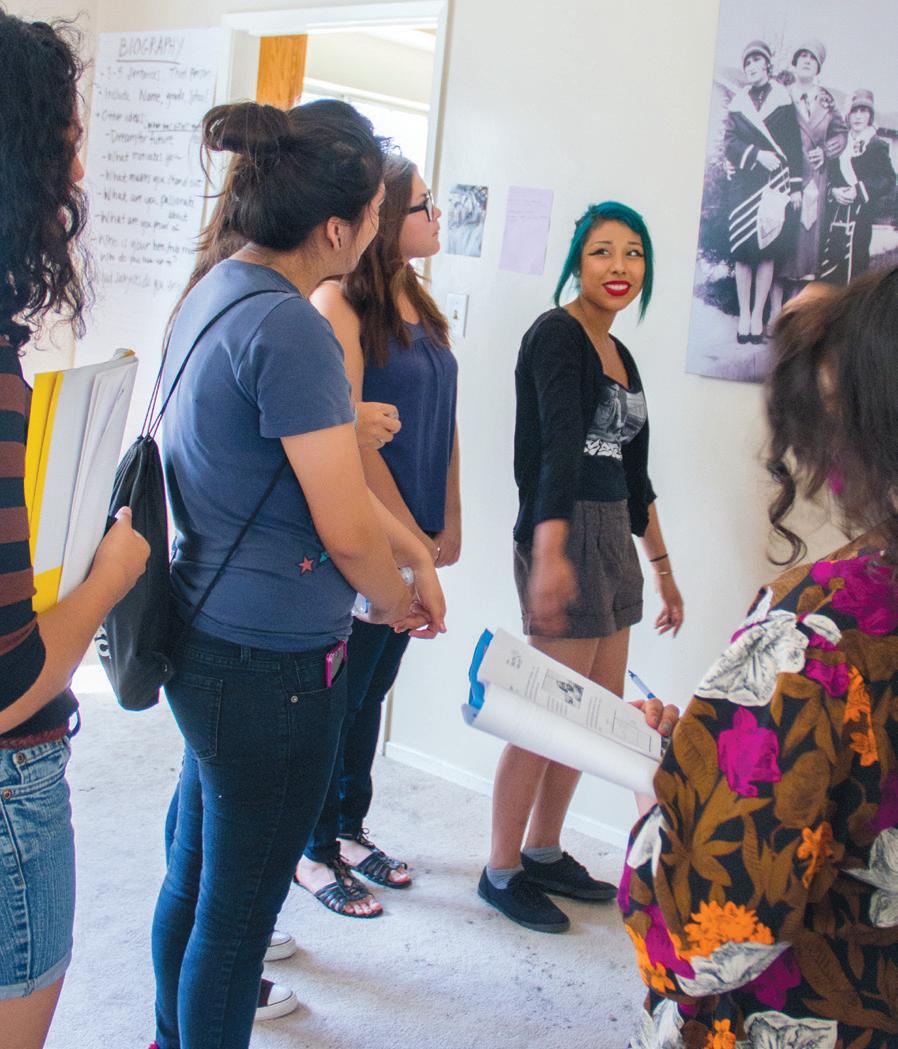
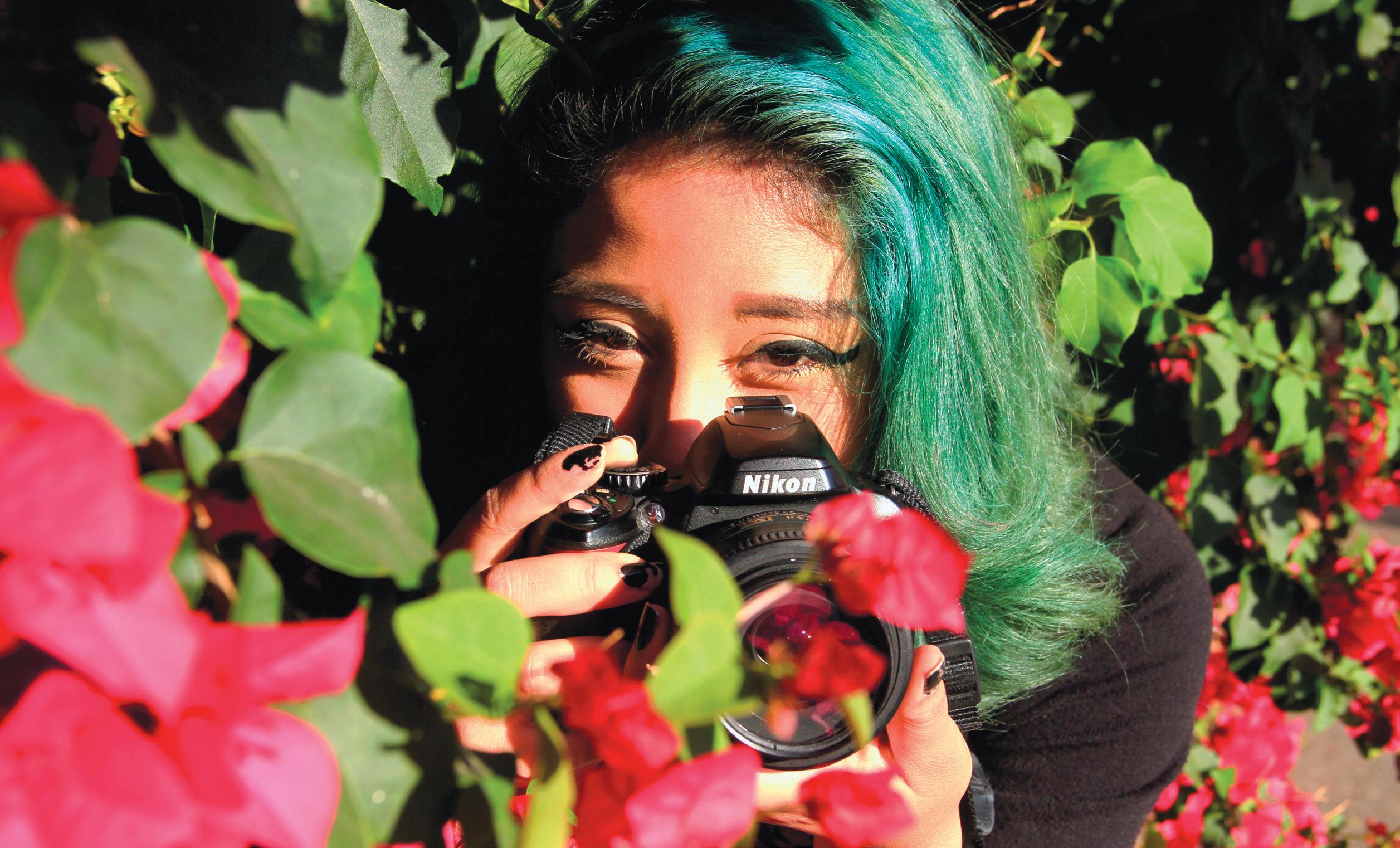
Ayoung woman’s voice floated through the screen door of a Boyle Heights house, grabbing the attention of several young girls, cameras in hand.
“What do you think of this photograph?” asked Claudia Marquez, a 23 year-old California State University, Fullerton student. “How do you think it was shot?“
The girls looked at the photographs in-depth, and silence filled the room. Soon enough, the wall-to-wall photographs sprang to life as the girls described what they saw or what the photograph meant to them.
“I am really excited to contribute to my community and invest in the creativity that is here,” the newly volunteered mentor of Las Fotos Project, Marquez said.
She finds it to be a safe place for young girls to explore their identity
and cultivate their self esteem.
Stephanie Alvarado, 17, joined Las Fotos Project to learn more about photography. Alvarado has been inspired by Boyle Heights’ empowering and uplifting street art and murals. Photography, she said, is the same. It impacts and changes minds.
Las Fotos Project has given Alvarado not only exposure using a camera but also a sense of community and togetherness.
“We empower each other and learn from each other every session,” Alvarado said.
Las Fotos Project is more than just teaching girls photography, but safely encouraging individuality, optimism, creativity, persistence and education. These are the five core values that given to the teachers, mentors and team members to express to students of the project.
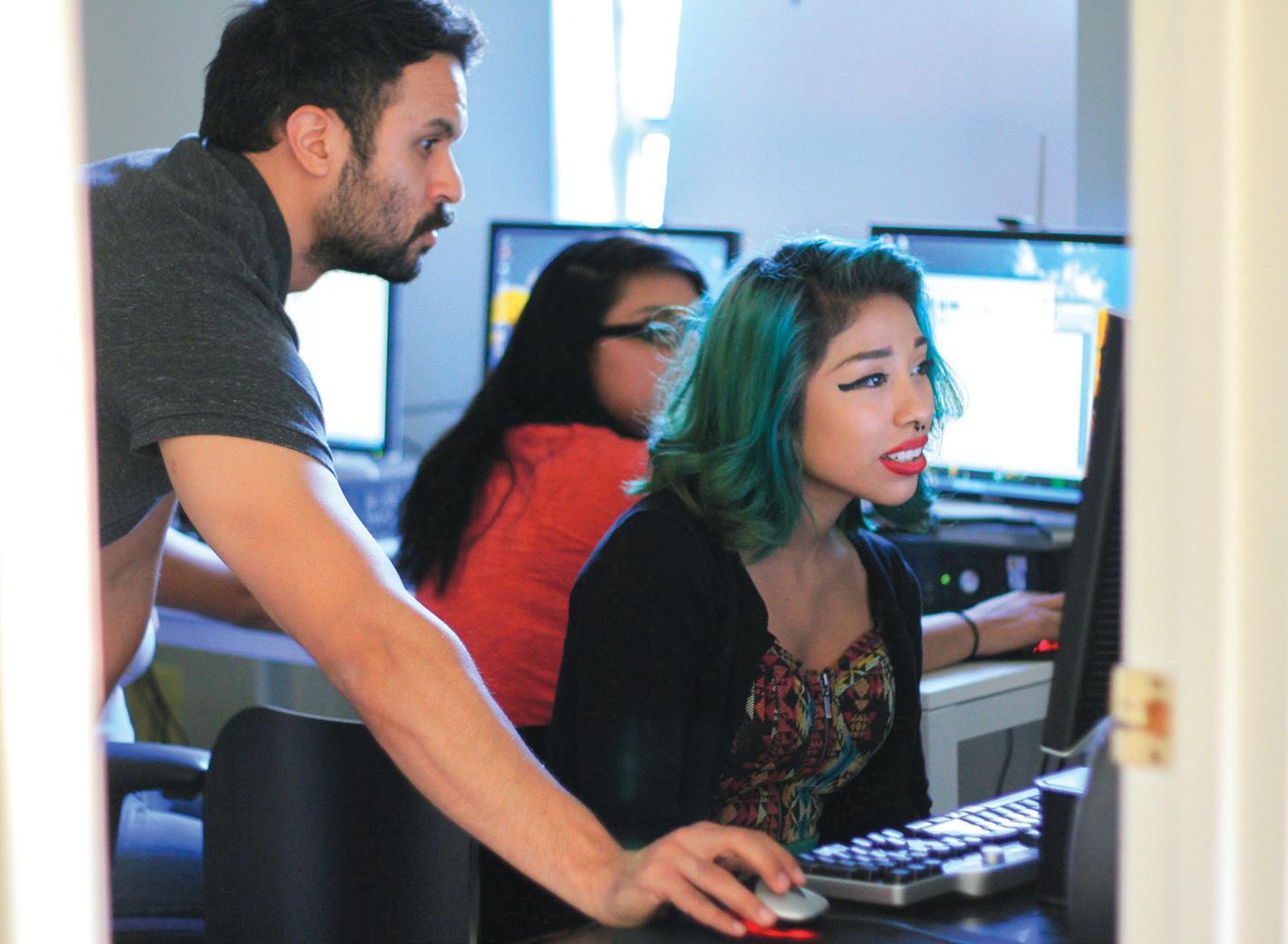 Top: Stephanie Alvarado, captures the foliage in Boyle Heights.
Bottom left: Director Eric Ibarra helps Alvarado write her theme.
Bottom right: Students of Las Fotos Project analyze a photograph.
Story and Photos by: Monica Salazar
Top: Stephanie Alvarado, captures the foliage in Boyle Heights.
Bottom left: Director Eric Ibarra helps Alvarado write her theme.
Bottom right: Students of Las Fotos Project analyze a photograph.
Story and Photos by: Monica Salazar

It is midday and the sun is beating down on the traffic-filled street. A yellow cab pulls up to the curb and an attractive, petite, well dressed female pays the driver and stiffly makes her way to a restaurant patio. She sits away from the sun, leaves her sunglasses on and puts plugs in her ears. A car alarm goes off, and she winces with pain.
Heather Howe lives everyday in pain. She twisted her ankle while dodging a taxi in New York in 1998. She went from cast, to cane, to crutches and then a wheelchair, not understanding what was wrong with her.
When finally diagnosed, she was told she had Reflex Sympathetic Dystrophy (RSD), also known as Complex Regional Pain Syndrome (CRPS).
RSD/CRPS is a chronic pain condition in which high levels of nerve impulses are sent to an affected site. Experts believe that the disease occurs as a result of dysfunction in the central or peripheral nervous systems.
Story and Photos by: Lynn Levitt Heather Howe holds a photo of her mild Reflex Sympathetic Dystrophy/Complex Regional Pain Syndrome (RSD/CRPS), flare up. The odd position of the toes is referred to as dystonia, which can come from physical trauma.
Heather Howe holds a photo of her mild Reflex Sympathetic Dystrophy/Complex Regional Pain Syndrome (RSD/CRPS), flare up. The odd position of the toes is referred to as dystonia, which can come from physical trauma.
There are three stages of RSD/CRPS, and the debate is still open for a fourth stage. A victim of disease doesn’t necessarily go from stage one and work through to three or four. RSD/CRPS can start at stage three.
“What I was feeling was unlike any other pain I had experienced in my life. [The foot] was enormous. It looked like I had elephantitus. It was twice the size of a normal foot, maybe even larger. I had absolutely no idea what was wrong with me,” she said.
After going from one doctor to the next, Howe found a doctor who was educated about RSD/CRPS but was first immediately admitted to the hospital.
“They did some testing on me to check my blood flow and my circulation,” Howe said. “There was very little blood getting in or out of the foot and then came a discussion about amputation.”
A phenol sympathectomy was done on Howe to define RSD/CRPS and help relieve the pain. Phenol was injected into the nerve ganglion connecting nerves from the brain, which is where it lives. The process sounds simple: the pain switch stays on, the body part nerves are over stimulated, the body goes into flight or fight mode and the pain continues long after the initial trauma.
Although RSD/CRPS can go into remission, there is no cure.
“There is only one way to say this,” Howe said, “They botched it.”
Howe could not straighten her leg out, and it took a year before the foot became better.
“I didn’t need to get it cut off,” Howe said. “I have both feet. I am very, very lucky.”
The RSD/CRPS has now spread through her body. One of the treatments Howe uses is
an injection of trigger points.
Dr. Brendan Murray is a team doctor, co-chair of the Medical Board for the USA Olympic Weightlifting Team and founder of The Institute for Spine and Sports Care in Santa Monica.
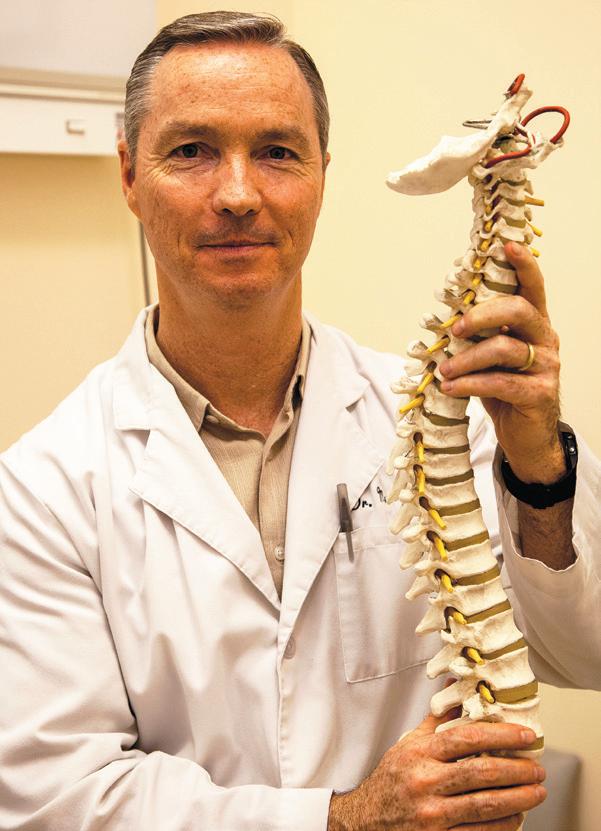
“What we have found is a treatment that is very effective [for RSD/CRPS]. An anesthesiologist will go in and put a small amount of medicine called lidocaine into the ganglion, which is a communication center of that nerve. It almost shuts it off, and now we can go in from a therapeutic perspective and reestablish motion,” Murray said.
Depression is a side effect of RSD/CRPS.
“If you are in a wheelchair and you can’t walk and you can’t do what you love, you have family members who give up on you and they turn their back on you and friends don’t come to visit you anymore; it is a natural, logical human thing you would be, at some point, depressed,” Howe said emotionally.
Howe tries to stay positive and continuously seeks normalcy. In between severe bouts of pain, Howe is a working actress.
“I was going to auditions on crutches and telling casting directors that I just twisted my ankle and I was going to be better any day because I needed to have that normal,” Howe said.
One of those auditions was with producer/ director Jess Mancilla.
Another alternative was to be outfitted with an external spinal stimulator.
”My purpose for wearing the external stimulator was to see if I would be a good candidate to have it implanted,” Howe said.
The stimulator generates tiny electrical pulses that are sent to the spinal cord. These electrical pulses block pain signals before it arrives at the brain, replacing it with a tingling sensation called pareshesia, according to Advanced Neuro-Modulation Systems, a St. Jude Medical Company. As much as Howe wanted to emulate Darth Vader, the internal stimulator was not an option.
“The next brilliant idea,” Howe said sarcastically, “was to put a morphine pump into my abdomen. More excitement, more Darth Vader.”
“She is most versatile and natural to work with. She is very talented, creative and attractive. In this business she is the total package. She has all the elements,” Mancilla said.
It’s been 15 years now. Howe survives on a regimen of lumbar sympathetic blocks, medication cocktails, neuro-feedback, biofeedback, acupuncture, anti-seizure medication and antidepressants. For Howe, acting is the incentive that keeps her going.
The sun is disappearing, and the air temperature drops. Howe has a slight chill. She reaches into her bag and takes a couple of pills for pain. She is going to help a friend at the theater that night. Howe knows about deferring focus to something positive and masks her pain, but she really wishes she could just lie down and sleep.
• Burning pain in the arm, hand, leg or foot
• Pain changes in intensity, but feels much worse than expected
• Loss of fine motor control
• Tremors or spasms
• Stiffness
• Hypoxia (deprived of blood supply)
• Changes to the skin, hair and nails on the affected limb
• Sympathetic nervous system dysfunction
• Somatic nervous system dysfunction
• Neurogenic inflammation
• The affected limb is warmer or colder than the unaffected limb
• The affected limb is sweatier or drier than the unaffected limb
• Edema (Swelling)
• Rated as the most painful chronic pain disease that exists
Dr. Brendan Murray explains how the nervous system relates to the spine `and `treatment for CRPS in Santa Monica.“There is only one way to say this. They botched it.”
Heather Howe
Graffiti is a creative street art that has proven to be one of the more intense and attractive kinds of street art.
Graffiti may have existed since the beginning of time when cavemen wrote on stone walls during the 19th century. As cultures evolved, Egyptians wrote on the pyramids, temples and tomb walls.
Graffiti has not always been accepted by mainstream society. Police regard graffiti as vandalism and often arrest those who attempt to put their art in public places. Still, some graffiti art has been elevated, exhibited in places like the Museum of Contemporary Art. The United Kingdom’s Banksy, who has received international acclaim is one such example.
For many years Los Angeles, has been an epicenter of urban art. Many now famous artists have gotten their start on the streets of the city, like an up-and-coming artist who goes simply by “Apathy.”
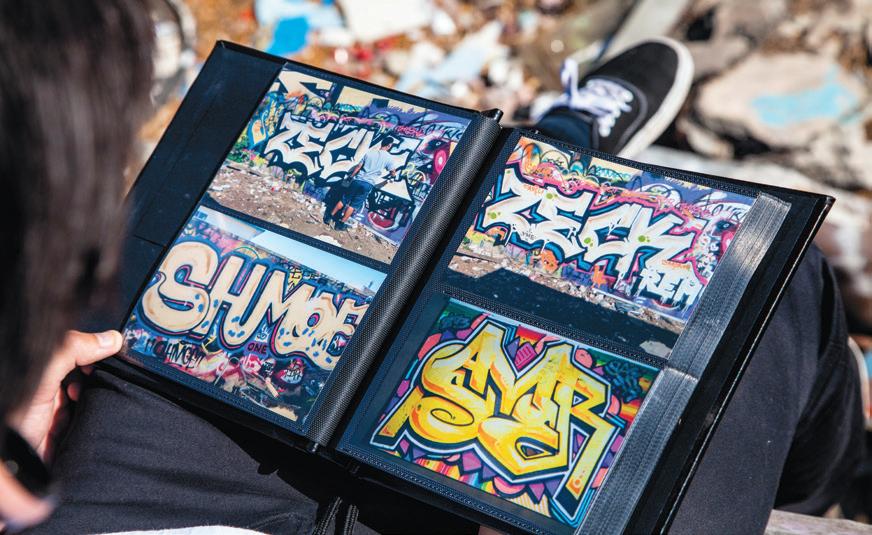
“My style is different from everybody’s. I like to think outside of the box. My designs are one of a kind, and I enjoy working on new designs when I think one out,” 18-yearold Apathy said. “Graffiti is one of my main passions, and whenever I see someone look at
my art I feel like people look back and change their opinions.”
Many graffiti artists use different effects and art designs to grab peoples attention, even adding signature characters and effects.

Another young artist, Carlos Mercado, uses of vibrant colors like turquoise, yellow, coral, blue, orange and many others so he can stand out.
still hire artists to paint a mural on their house. That gives many artists the opportunity to save themselves from receiving fines for something that will be covered eventually.
Venice Beach also allows artists to paint on its walls as long as the artist acquires a permit.
Joseline Rios taught an art class at Antelope Valley College in 2007. As an enthusiast, Rios participated in art walks in the San Fernando Valley for the past two years.
“I don’t consider it vandalism if what the individual paints is art and has character. I enjoy the beauty and creativity of every individual’s art and think they should be recognized as great inspiring people of their communities,” Rios said.
As society grows to expand and open its collective minds on the social impact of the world, new generations are learning to accept graffiti and the artists that influence them to be someone different in this world.
“Graffiti for me is free. I like the idea of going out, painting what you want, wherever you want, at whatever time you want. It’s therapeutic just to go out and do something away from everybody else while listening to some music and just being on your own,” Mercado said.
While graffiti is illegal, homeowners can
“Being capable of creating anything from scratch, making it amazing and something for people to make a memory from it is something amazing people just want to be appreciative and noticed,” Rios said. “I taught because I loved to work with gifted students who didn’t realize that they have such an amazing talent.”
Story by: Jonathan Pineda Photos by: Lynn Levitt“I enjoy the beauty and creativity of every individual’s art and think they should be recognized as great inspiring people of their communities.”
Joseline Rios

“Graffiti, for me, is free.
I like the idea of going out, painting what you want, wherever you want, at whatever time you want. It’s therapeutic just to go out and do something away from everybody else while listening to some music and just being on your own.”
Carlos MercadoCan of paint in hand, Mercado poses in front of his art.
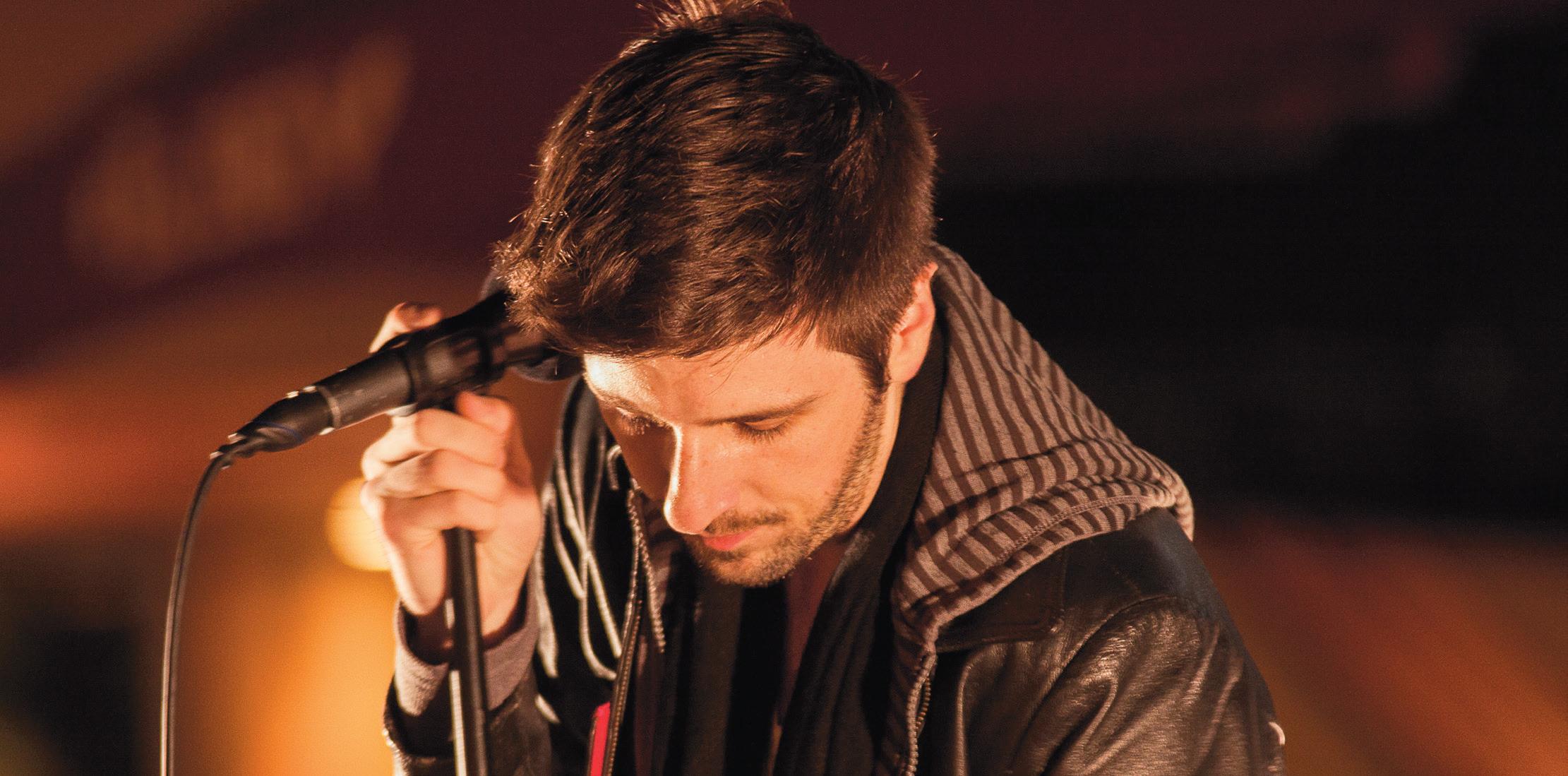
At The Jon Lovitz Comedy Club, Greg Wilson is slaying the crowd with his infectious mixture of playful jabs at the audience and material that he has compiled and reworked over the years. Like a skilled lock-pick, every phrase he utters is made to pull the little levers in people’s minds. The result is undeniable. People are helplessly amused as laughter fills the club. Not just any comedian can conduct this type of electricity into the crowd, and Wilson is a veteran who knows the craft inside and out.
A different ambience is unfolding at The Coffee Bean & Tea Leaf off of Ventura Boulevard and Woodley Avenue. Jason Brain is preparing for his weekly performing art showcase, ‘Soapbox Sessions,’ where different poets, musicians and other performers gather to showcase their acts. Although just starting out, Brain is meshing the urban and beatnik scenes with a mixture of music and mirth.
Both are on opposite ends of the entertainment scene, but they share a common passion: performance art.
When Wilson is on stage he commands attention. His presence pushes aside boundaries and drives home amusing anecdotes about everyday life and his unique appreciation of the human condition. He is fearless, unapologetic and brash. This is a winning combination that has propelled

“Comedy is a life’s choice. It isn’t something like, ‘I’m going to do it for three years, see what happens.’ Quit. Go spend that time doing something that you really want to do with your life,” Wilson said. “It takes as long as it takes.”
At ‘Soapbox Sessions,’ poets are finding a place to practice their prose with other folk. Brain knows how hard it can be becoming an established poet. Going through the rigors of searching for a good publisher, Brain decided to get his own publishing house started after writing his book ‘Mixtape Collection.’
“The name is ‘Poetry In Motion Publishing House,’” Brain said. “We’re trying to promote other artists as well in the area.”
Those who are just getting established can network through communities like Brain’s to get exposure. This might land a performer an industry gig.
Wilson remembers his anxiety about being featured for the first time on Vh1, before he became famous.
“I couldn’t watch it. I was too nervous. So I’m out just roaming around my neighborhood, just walking around,” said Wilson, reminiscing. “My manager’s calling me and he goes, ‘You just got a major part. They just used one of your punchlines, and you’re on the bumper going out and the bumper coming in.’”
Wilson said that was a turning point for him, where he had “pierced the veil.”
Brain, on the other hand, was first exposed to the open mic experience at the valley’s iconic Cobalt Cafe in Canoga Park.
“That’s where I learned that an open mic exists, that these things exist at nights behind the scenes that people don’t see,” Brain said.
Wilson into the role of national headliner. Before his open mic night, ‘Soap Box Sessions,’ Jason Brain checks equipment. Onstage, Greg Wilson stirs up some laughter. Story by: Jeremy Nation Illustration by: Lauren Vellvé“We had people who were there to see it succeed, who wanted to see it happen.”
Jason BrainPhoto by: Lisa Richardson Photo by: Mohammad Djauhari
On the other side of the big break, Wilson can appreciate where he’s at now.
“That’s when it’s magical. It’s when it’s swirling in and out,” Wilson said. “It’s almost out of control but in control at the same time.”
Once he gained strong footing in the industry Wilson saw a need for up and coming comics seeking a shot at the big time. He developed a workshop that has accumulated a steady flow of students seeking to learn the tricks of the trade. Wilson shows newbies need-to-know techniques that veterans hone over years of ups and downs.

Wilson’s workshop had humble beginnings, but today he has several classes covering all the major dynamics of stand-up comedy.
“I’d never seen a good comedian teach,” Wilson said. “And so that really bothered me that there was no quality stand up education out there.”
Back in Reseda, Brain knows that it’s not always easy to find success. Only after bouncing the idea off his boss was he able to establish what’s becoming a regular part of the Encino nightlife.
“Knowing we had the beautiful space here at The Coffee Bean & Tea Leaf and the perfect venue to do this, I mentioned it to my manager kind of in passing, and he liked the idea,” Brain said. “So thankfully we had people who were there to see it succeed, who wanted to see it happen.”
Some businesses are built on the model of dinner and a show.
At Ventura Harbor Comedy Club, coowner Randy Lubas has been a patron to the arts for many years. He provides a platform at his club and as a talent coordinator he’s focused on helping up-and-coming college students break into the scene.

Lubas is glad to have Wilson headlining his club.
“The audience loves what he does,” said Lubas. “That’s one of the best things you can have going for you as a comedian.”
At home onstage, Wilson’s performance seems to have captured it’s own life, a sort combination of riffing and material. Wilson is really ripping into the audience now. He’s found the members of the crowd who stand out and they become a part of the show. The half-Irish girl is confronted by Wilson whose
spot-on impression of an Irish grandmother makes her and everyone else laugh. Since it’s
“Latino Night” at the comedy club Wilson proclaims he’s half Mexican and will bus your table right now if you don’t believe him. Taboo or not, people are cracking up.
“There are shows and there are magic shows, magical performances,” he said. “And that’s when the material and the riffing are weaving in and out of each other in it’s own thing. It’s happening on its own, you know, and I’m just kind of riding it. I’m not creating it, I started it, but now I’m just riding. And those shows, it’s like a 90 minute orgasm.”
“There are shows and there are magic shows, magical performances.”
Greg Wilson
In the intense hot heat of the summer day, in the football stadium at Los Angeles Valley College, parents are waiting patiently in the bleachers. The sun continues to beat down on them. They are uncomfortable; they seem to be suspended in a shared state of calm anticipation.
The silence is broken as cheers erupt from the crowd. Students follow one another in a straight perfect line as they descend the stairs leading to the commencement platform. As they shout, screaming out their names, the graduates walk on the field for the ceremony.
The ceremony ends. Across the green cut football field, the graduation caps are thrown into the high clear fresh air and come tumbling back down.
After graduation, some high school students go to college, some to work, but
there are some, such as Brian Cooper, who choose to serve their country.
Before being accepted into the armed forces, Cooper and other prospective graduates must undergo rigorous training exercises as part of the recruiting process. Training involves exhaustive crunches, pushups, pull-ups and running a long dirt track field.
While they might end up feeling exhausted and losing their breath, they have to undergo this type of activity for up to two weeks to prove they’re in shape.
When the day comes, recruits go through the final administrative process at the Military Entrance Process Station.
“I didn’t want to go to college at that time; I was feeling patriotic,” said Cooper, 22, who went to the Marines instead of going to college. “I felt indifferent leaving my family

and friends.”
The United States Marine Corps allowed Cooper to find out a lot about himself .

“The hardest challenge was the boot camp hikes,” Cooper said.
The West Coast is known for all their hills, including a huge steep one called “The
Story by: Raymond Chavez Rodriguez Jr. Photos by: Lynn Levitt Photo Illustration by: Jeremy Nation Former United States Marine Brian Cooper smokes a cigarette. During his three-year stint with the Marines, Cooper became a chain smoker.“Marines do crunches, the Army does push-ups.”
Sergeant Sergio Lopez
Reaper.” The hill is designed to scare or frighten some recruits.
Cooper did not see action, but he volunteered five times. Cooper said if he had stayed in the force, he would be sargent, but that was not worth it. Also, he said he was never going to receive oversees deployment, which is what he wanted. Cooper left the Marine Corps on Administrative Separation.
When Cooper came home, he was able to reconnect with friends and family whom he didn’t see for three years. Crashing into a class for History 1 at Pierce College, Cooper focuses on school.
On the other side of the recruitment coin is the trained professional, inducting recruits into the world of military service. Sargent Sergio Lopez is 26 years old and is a Marine Corps recruiter. He joined the group at 20 years old.
“Before joining the Marines, I was a typical
high school student, and I was very active, but I didn’t really [have] a direction in life,” Lopez said.
Lopez said his life changed by 180 degrees. He didn’t think college was for him, but the Marines helped him succeed in life, and he is still involved recruiting the next generation of Marines.

“To become a Marine,” Lopez said. “You have to take an Arms Service test, which includes math, English, science and physics.”
Recruits are required to take a sports physical, which is an overall check on your body to make sure you’re physically fit to join.
The Initial Strength Test for the males consists of five pull-ups minimum, a oneand-a-half mile run in 12 minutes or less and 55 crunches in less than two minutes. For females, it’s a 23-second flexing arm hang, 14-minute mile run and 45 crunches in less than two minutes.
“Marines do crunches,” Lopez said. “The Army does push-ups.”
Lopez served one year in war and saw that the real world is not a Hollywood movie.
When Lopez fought in Afghanistan in 2010, he helped to secure hostages and fend off counter insurgents. As a first responder, his actions helped secure the safety of individuals. Lopez administered First Aid to rescued prisoners of war and helped his unit evacuate them to a safe location.
Another recruit who wants to have his life straightened out is 22-year-old Gabriel Araujo.
“For me, I was immune to college,” Araujo said over Skype. “I was a messed-up kid. My parents keep kicking me out off the house a lot. If it wasn’t for the Marines I would be dead or locked away.”
Araujo hasn’t been deployed. He checks back into his unit once a month because he is in the reserves.
“Hopefully I get deployed,” Araujo said. “I want the Marines to change my life to be better, to have a family, finish up school, to build myself a house and I don’t want to live on the street. This is why I am signing up for the U.S. Marine Corps.”
The U.S. Marines Corps said that they could help Araujo and others.
According to the U.S. Military’s web “Top three reasons to join the Marines,” those who sign up will have the honor that comes with being part of one of the most vital military institutions in our nation.
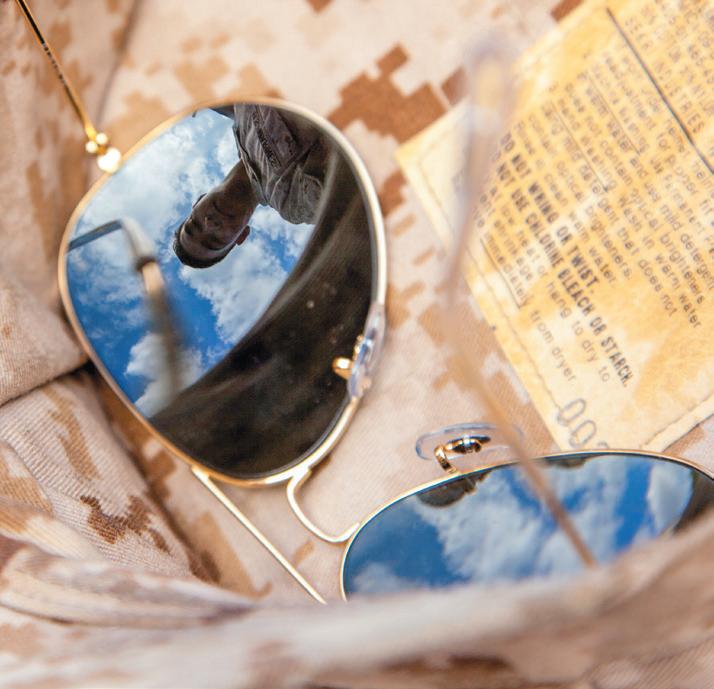
Also, they will be able to improve physical fitness, health and nutrition, and live a fuller and healthier life overall, both while a member of the Marines and after as well.
They will become one of the few, the proud.
To some, this may just be a commercial, but to those who live it, they believe that it’s more than just a mere advertising slogan. It’s a way of life.
“I didn’t want to go to college at that time; I was feeling patriotic. I felt indifferent leaving my family and friends.”
Brian CooperSgt. Sergio Lopez leads a group of future and current recruits and educates them on different levels of income they may earn as they move up the ladder in the Marine Corps.
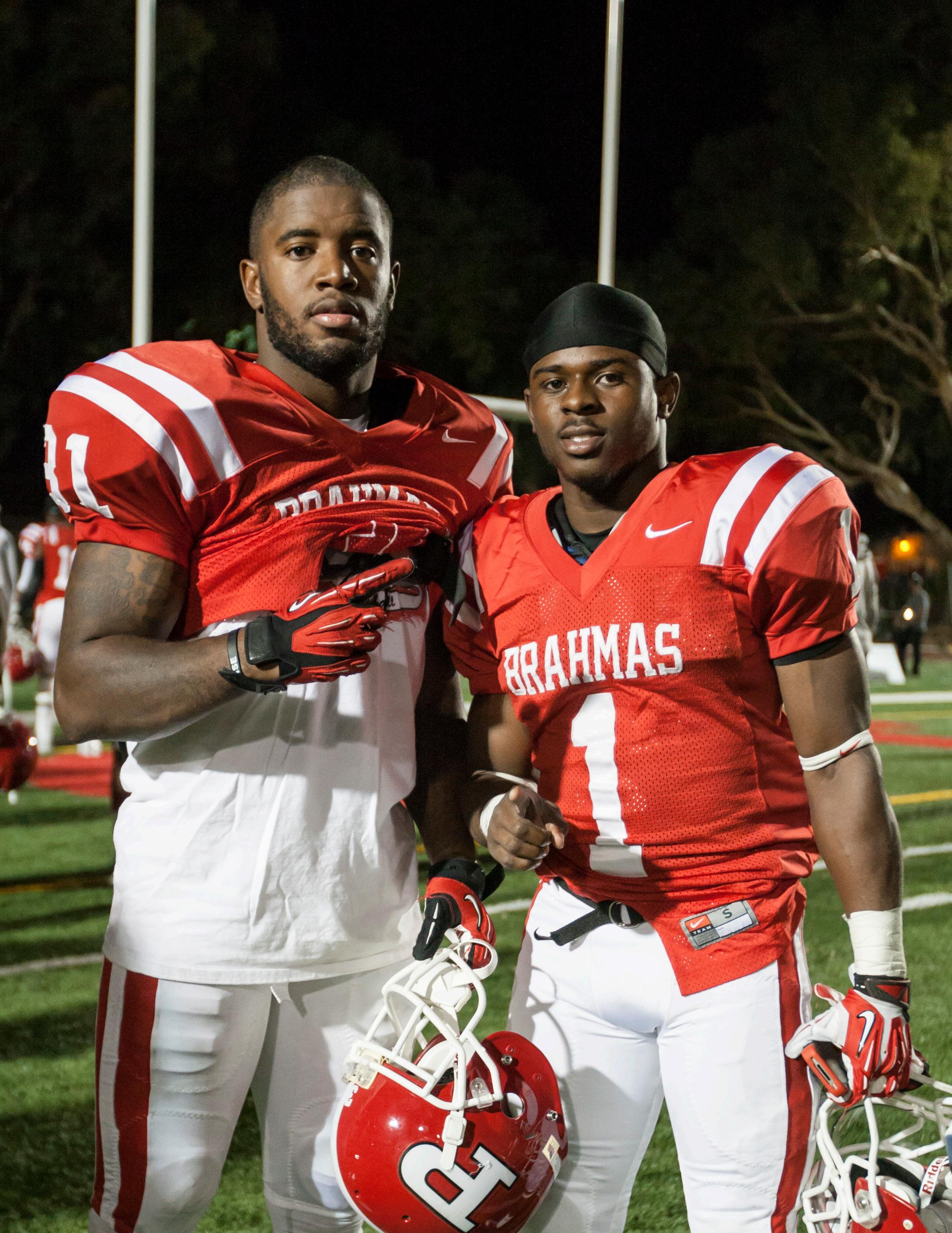 Story by: Ashley Walton
Story by: Ashley Walton
For running back Joshua Mathis and defensive back Amir Muhammad this is more than just a quote from their head coach, it’s a promise to themselves.
Both hailing from Philadelphia one may think that they have been lifelong friends. Muhammad, originating from North Philadelphia, and Mathis from Olney merely 15 minutes away, could make this assumption more believable.
Even though they did not become friends until attending Pierce College they both shared one common interest: football.

For most students, traveling to attend their dream college remains a dream that seems out of their grasp.
For Mathis and Muhammad, this dream turned into a reality.
Defeating the odds seems to be one of the main focuses for Mathis.
Being the father of twin girls is also one of his motivations toward accomplishing his goal of becoming a professional football player.
Each week, Mathis has been showing his dedication on the field as he makes his mark on the team.
Despite the misjudgment made toward Mathis and his size, he has overcome and defeated many challenges.
During the Brahmas’ first home game this season, Mathis scored a touchdown.
“He’s an extremely fast player, but since he’s undersized he’s going to be discriminated against. I told him that the way you get people to not discriminate against you is you go out
and perform your best on the field when you can,” Martinez said.
With a beaming smile on his face, Mathis doesn’t look like he has a single care in the world.
However, Mathis says that it can be stressful at times when you have so many things to juggle as a college student. He counts Pierce as a blessing and is grateful to play for the college.
“I knew a lot of friends that was out here already, so this was a good fit from me and so I came out here,” Mathis said.
Having tunnel vision is what takes some of the stress away from Mathis’ life.
“Concentrate on one thing,” he said. Mathis plans to stick to football.
“I only have a Plan A, that’s it! It’s to get in there and play,” he said.
Muhammad mumbles to himself.
“Finish what we started.” This is a promise Muhammad holds very dear to his heart.
A few months ago, his mother lost her 26year battle with Lupus.
“My mother was everything to me,” he said.
Her unexpected death caused Muhammad to push himself harder.
Gazing down to his wrists are two visible “I Promise” bands. This is a constant reminder of all the promises he made to her.
Muhammad said that he owes it all to his mother, even his interest in Pierce College.
“I had just about given up on football and I told her about an opportunity for me to come out to California and she was excited. Probably more excited than I was actually.
Some friends had informed me on the school and I did my own little research and took it back to her and once I did she was sold on it basically,” he said. “She sent me out here on her last dime it was like her last wish basically before she passed and me leaving was actually the last time I saw her alive. So everyday I wake up I remember that I’m not only pursuing my dreams but fulfilling her work - her legacy and repaying a debt I owe her.”
Muhammad also isn’t afraid to showcase his talents on the field.
“Muhammad has great size for a corner; he has the look that most D-1 schools are interested in,” Martinez said.
With his strong athletic ability, it is no surprise that Muhammad is in communication with many D-1 and D-2 schools.
Juggling being an athlete and attending college, Muhammad said, “It is very, very stressful sometimes.”
He said he can feel very overwhelmed but handles it by “not trying to do two things at once.”
Muhammad tries to stick to one thing at a time.
“If you have practice, concentrate on practice. Don’t be at practice worried about a paper,” he said. “If you’re in class, don’t be in class worried about practice. If you’re in meetings worry about meetings. That’s it.”
Being the father of a young son, Muhammad also has to deal with the homesickness. He said that it is hard at times to be away from him but is ecstatic to see his son following in his footsteps of becoming a football player.
In the meantime, Muhammad is focused on finishing what he and his mother started together.
“Never give up.”
“My mother was everything to me.”
Aviation has come a long way since the Wright brothers first took flight. Though now incorporated into the cycle of modern day life, few can say they’ve flown or been in an open cockpit biplane. Not chafing away the raw experience of flying, there’s something different about seeing the world 360 degrees openly; feeling the wind rush by, and hitting your face as you slowly get away from everything down on land.
“I don’t even think most of us are aware of it. As you’re getting ready to fly, and getting the airplane ready, you don’t normally realize you’ve stopped thinking about everything else in life. You’re getting ready to fly. And as you lift up, you literally leave everything behind you on the earth as you lift up into the sky. And it’s a freedom like no other,” said Mike Hanson, a pilot of an open cockpit WWII biplane.
“Aviation is a world unto itself, and the open cockpit biplane is a world within a world. I guess the closest analogy I can use is it’s like a Harley with wings. When you’re driving in a car you put up the window, you’re in a closed cabin in a vehicle or car and you’re driving along and you can see everything, but the minute you get on a motorcycle, you’re in the environment, same with the open cock pit biplane. You’re in the sky, you can hear the wind and you’re part of the sky,” Hanson said.
“The closest freedom to that I know would
be diving, free diving, underwater. It’s like its own world, a world within a world. So I like the freedom of flying.”
Hanson always had a young boyhood dream of flying but pursued it later on because life got in the way.
“At 39 years old a friend of mine, he had recently purchased this airplane, and it had gotten checked out in the Stearman. One day
to learn how to fly.
Hanson considers himself the caretaker of the plane, rather than the owner.
“Frank and I had a friendship, a good friendship, and I thought it would go on for many years. And Frank unfortunately four years later found out he had kidney cancer and five months later he was gone.”
About a month before his friend died, they had a conversation.
Frank said, ‘Mike, would you like to go for an airplane ride?’ and I said, ‘Sure, OK.’ I showed up not knowing what to expect, the hanger doors opened up. I looked at this airplane and I thought ‘Oh my goodness, what is this.’ We went for a very short ride. We were going to go to the beach, but there was a wall of fog. We had to make a U-turn and come back, and it was only 20 minutes. When I got out of the airplane it was as if every fiber of my being said ‘I have to know how to do this,’” Hanson said.
He enrolled in flying lessons, and so the joke is, it only took him 110 days and 20 years

“He knew he was dying. One of the things Frank said was, ‘Mike I hope to have my own wings where I’m going. Would you take care of this set of wings?’ So, from that time, January of ‘98 to now, I’ve been the caretaker of this treasured piece of aviation history. When reality set in, [my wife] and I asked ourselves, ‘Oh my goodness how do we keep something like this?’ And we started biplanefun.com, offering rides to people to help offset the cost of the airplane.”
“This airplane and nearly 10,000 like it were built by Boeing for the military during WWII. This was considered a primary trainer for the army and the navy, the army air core before the air force came into effect. So this airplane specifically has historical significance as a military trainer used in WWII.”
“For me and this airplane, my hope personally is to live to be a centurion, to live to be a 100. We will see, lofty goal. And I know some guys that are flying into their 80s, and I would like to fly into my 90s.”
“You literally leave everything behind you on the earth as you lift up into the sky. And it’s a freedom like no other.”
Mike HansonMike Hanson prepares to take flight in his inherited biplane.
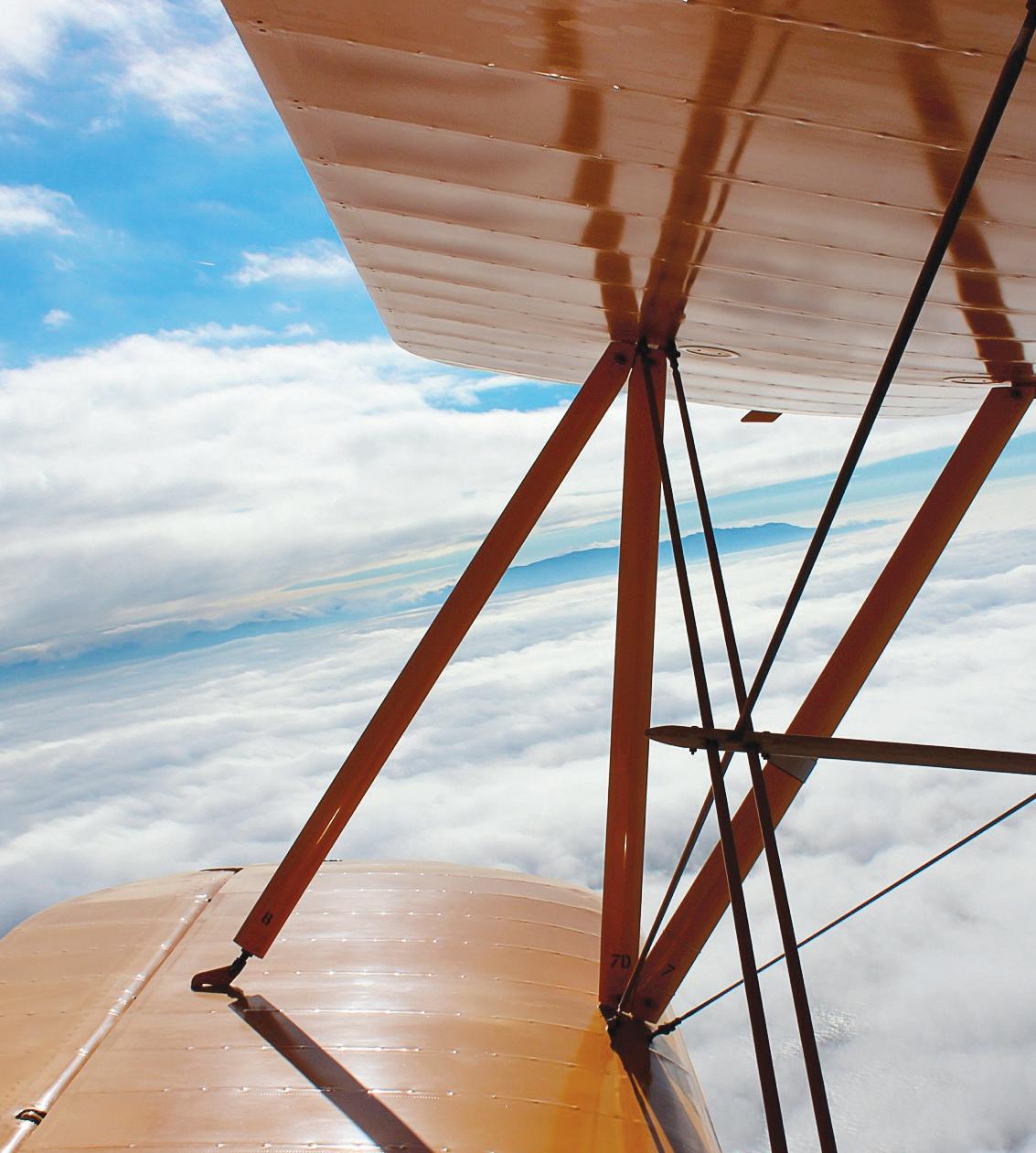
 Soaring in the open air, soft clouds stretch out across the blue horizon.
The World War II stearman in its hanger waiting for takeoff.
Soaring in the open air, soft clouds stretch out across the blue horizon.
The World War II stearman in its hanger waiting for takeoff.
The catchy cartoon jingle of “Little Einsteins” is drowned out by the even louder sound of an iPad. Inches away from the SmartGlass screen, fixated on the device held to his face, a toddler perches on his elbows and ignores the world

around him while his mother picks up after him.
Gabriela Lopez, the boy’s mother, walks around him and picks up a purple-and-blue blanket he had been playing with earlier and asks him if he is hungry. But, Lopez’s son, Andy, ignores her question as he walks away from her.
Three-year-old Andy loves to play video games.
“Believe it or not this really helps me with him,” said Lopez, pointing at the iPad and signaling to Andy with pursed lips. “He’s a brat. He cries until I give him what he wants.”
Lopez is the mother of three children, 9-year-old Kathy, 5-year-old Digo and Andy.
Raising three children so close in age isn’t easy for Lopez. She is a full-time mom and a part-time student. Lopez said it’s tough to run a home, go to school and tend to her children.
“My children are a handful,” she said. “[Especially] the boys but mainly Andy.”
To get an edge, Lopez is going high tech.
Andy Lopez works on his next Minecraft creation. Story and Photos by: Alvaro Gomez“Children tend to keep calm when they can physically hold something and touch and play with it.”
Kana Brubaker
Kana Brubaker, a pre-school teacher, said children from the ages of two to five are easily entertained by bright colors and sounds.
“Children tend to keep calm when they can physically hold something and touch and play with it,” Brubaker said.
Having a portable tool when dealing with a handful of children could be useful to a busy parent, but it’s not without its downsides.
For example, grocery shopping is not an easy task.
“If there is no Wi-Fi, I need to get in and get out,” Lopez said.
Lopez admits she allows Andy to use the iPad for long periods of time because it keeps him at ease.
After dropping Kathy and Digo off at their school and doing her daily chores, Lopez sits down to do homework. She sets out a juice box, a bowl of grapes and hands Andy the iPad. Lopez carries the iPad and the iPad
charger in her purse everywhere she goes.
In study done by a children’s psychologist Dr. Jordy Kaufman on whether the iPad helps or delays children’s brain development, findings showed that creative and calming activities on the iPad, like painting, are similar to the “real world.” It was revealed that these activities “do not seem to adversely affect
children’s behavior or attention in the short term.”
Andy wants attention and runs to Lopez and begs by nudging and biting her leg. With Andy sitting on her waist and putting a handful of her shoulder-length brown hair in his mouth, he asks, “Where the iPad?”
Lopez is embarrassed to admit how much the iPad influences Andy’s behavior.
She isn’t a pushover, but with Andy’s high spirited and tireless attitude it’s sometimes easier to calm him down with the iPad rather than make a scene in public when he doesn’t get his way.
Afraid that she may be judged by others or be seen as neglecting Andy, she says, “I’m not a bad mom.”
Lopez said that she disciplines her children with timeouts or with no TV when necessary. The iPad helps distract Andy from wanting things at the store and from fighting with his siblings.
All in all, Lopez is grateful to have technology to help.
“I can get things done easier if he has the iPad to play with,” Lopez said.

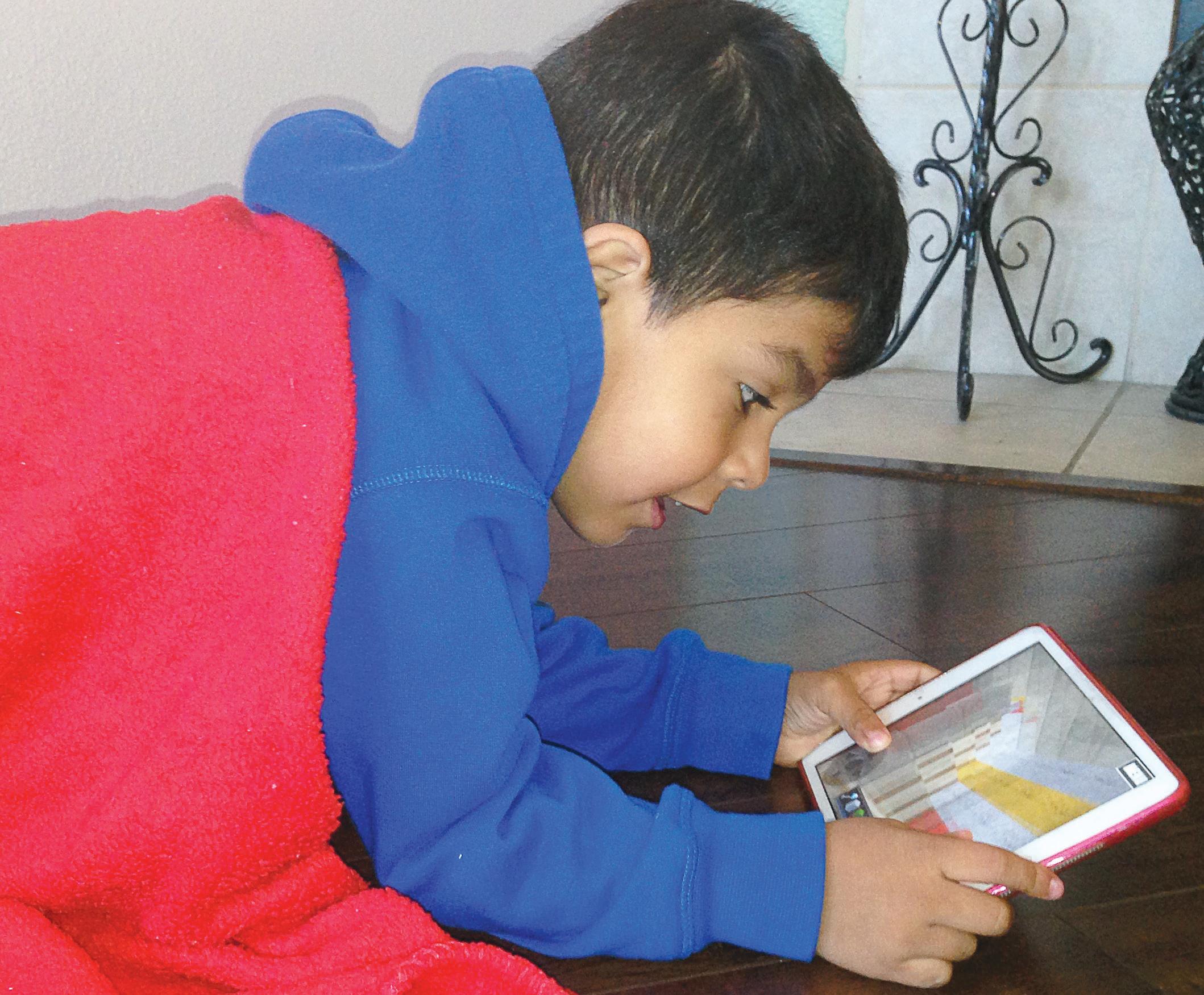
At the end of the long day, Andy, along with the iPad’s battery, are drained and exhausted to their limits. The iPad shows the drained battery on its black screen and Andy’s eyes are droopy and glossy with exhaustion.
“I finally get to do homework,” Lopez said. “And put them both to charge.”
Amusing himself with a dancing bear, Andy Lopez watches YouTube.“I can get things done easier if he has the iPad to play with.”
Gabriela Lopez
No physical evidence of ghosts exists on earth; however, ghosts have been defined as apparitions, translucent shapes, spirits or souls of a dead person or even animals. In Roman history, Pliny the Younger, an author and statesman, recorded one of the first notable ghost stories in the first century A.D.
As the years have gone by the ghost world has been grabbing the attention of many audiences from across the world. The phenomenon has changed thoughts and opinions.
According to a CBS news poll in 2010, about 48 percent of Americans believe in ghosts and have seen or felt a paranormal experience. The remaining percentage either doesn’t believe in ghosts or are skeptics.
One of those skeptics is Michelle Galvan, an 18-year-old Pierce College student who said, “This is all a conspiracy. Hollywood is trying to make us believe in ghosts with all the shows they’re producing so they can take money away from people like us. I’ve never experienced anything in my house and I’ve been living there for over 14 years. My great grandmother died in my house and I’ve never seen her.”
Hollywood is the entertainment capital of world, producing movies, music, television shows and more. As a necessity they must keep their audiences entertained. Networks are producing shows like ‘Ghost Hunters,’ ‘Ghost Adventures,’ ‘My Ghost Story,’ ‘Paranormal Witness,’ and ‘Medium.’
Movies like ‘Insidious Chapter 2,’ ‘The Conjuring,’ ‘The Sixth Sense,’ and ‘The Blair Witch Project’ may have made it even easier for the skeptics to not believe in the paranormal because of the Hollywood visual effects.
Josie Kapton is a 23-year-old Pierce College student who had her mind and life changed when a female figure appeared to her at night.
“At first I was really scared of what had happened. I saw this beautiful woman dressed in a nice white gown telling me things. I thought it was a dream but I kept blinking my
eyes and she wouldn’t go away, until I started talking to her,” Kapton said.
When it came to the paranormal, Kapton said, “I hated when people talked about ghosts. I used to think it was stupid, but after everything I’ve been through I had to change my mind about it.”
After what she had gone through, some of her friends started to suspect she was crazy, but in reality she thought she had seen a ghost. The only proof that she can gather was the one only in her memory.
Those who have ghostly encounters and want help can always seek out a ghost hunter.
There are hundreds of groups around the country that are interested in the paranormal and try to figure out if there are ghostly occurrences around their area.
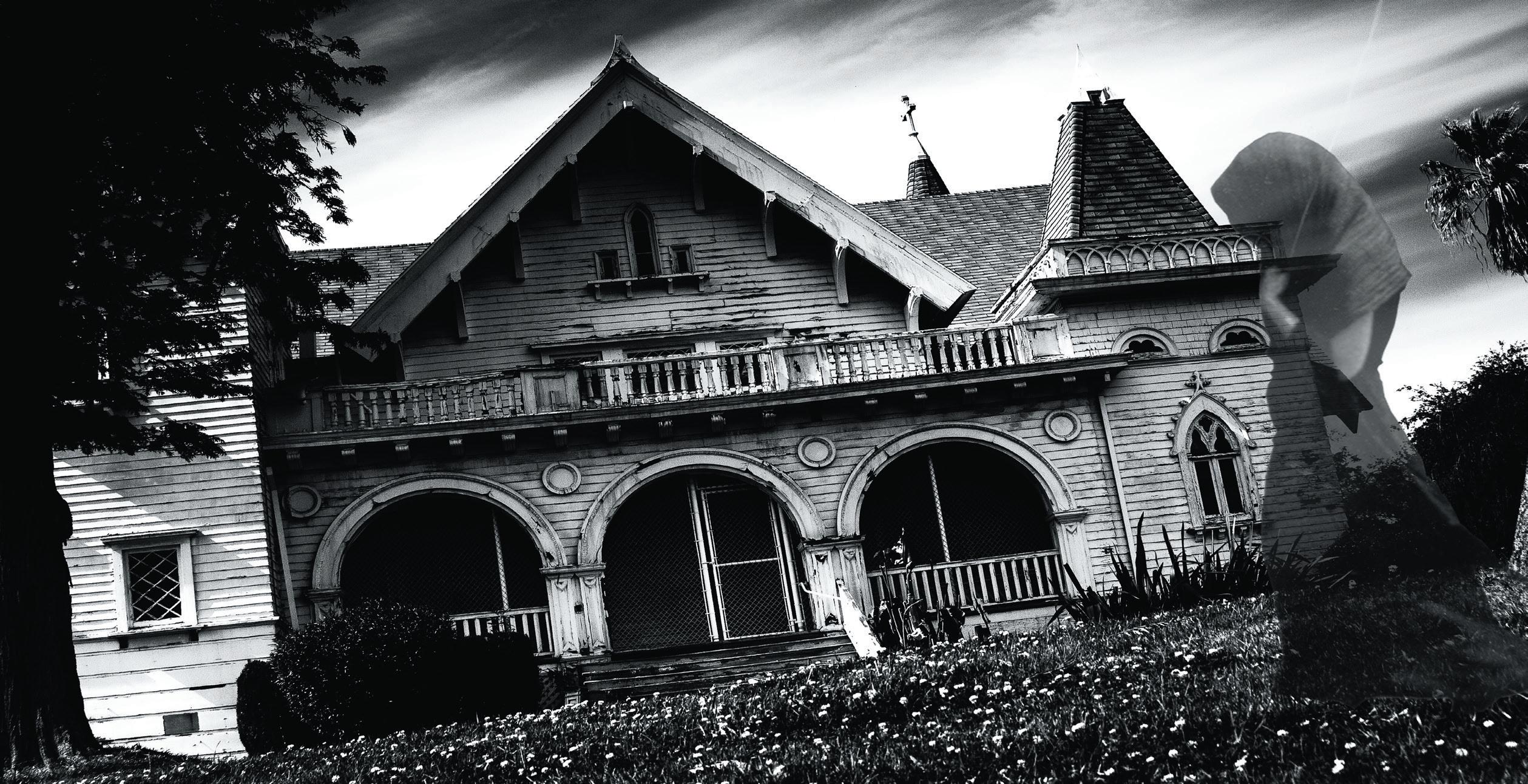
Erik Vanlier is a paranormal investigator who has a group based in the San Fernando Valley called Valley Investigators of the Paranormal.
“When I was a teen I would go with my friends to urban legends spots like Gravity Hills, some places in the Valley that were [Charles] Manson hangouts, and we would just see if the urban legends were true or were just that a legend. There were a few occasions where we had some unexplainable incidents,” Vanlier said.
One of Vanlier’s first major paranormal
“This is all a conspiracy. Hollywood is trying to make us believe in ghosts with all the shows they’re producing so they can take money away from people like us.”
Michelle GalvanStory by: Jeffrey Gonzalez Photos and Illustrations by: Lynn Levitt
investigations was at Linda Vista Hospital by Downtown Los Angeles. The 89-year-old building is said to be known as one of the haunted places in Los Angeles because of its paranormal attraction to the living world.
“I went to the Linda Vista Hospital before it had become popular and had an overwhelming feeling of sadness and despair. I got an attachment there and it caused me some problems at home ,and I was being affected with my life and I stopped for a while,” Vanlier said.
Some of his investigation stories have been featured in ‘My Ghost Story’ and he has worked with various people like the crew from ‘Ghost Adventures.’
Before the Valley Investigators of the Paranormal come to investigate a place, they do a background of the house. Once at the place they go around the house and make sure there are no animals. Then they try to see if the claims made by the customer can be debunked. They go in and record for four-to-six hours and take the information to their office to see if they caught any evidence.
“Ghost Hunting isn’t a game. Do it because you have an interest in it and you want to help people get answers. Don’t just watch a paranormal show and go trespass to an abandoned building, because you never know what you might be encountering. People can get attachments and can get physiological and physical problems,” Vanlier said.
The truth about ghosts may never be known and as technology advances, there will be better gadgets to support the paranormal or debunk it. Until actual substantial evidence appears, and brings skeptics over from the lines drawn in the sand, those who believe will have to continue onward with a leap of faith.

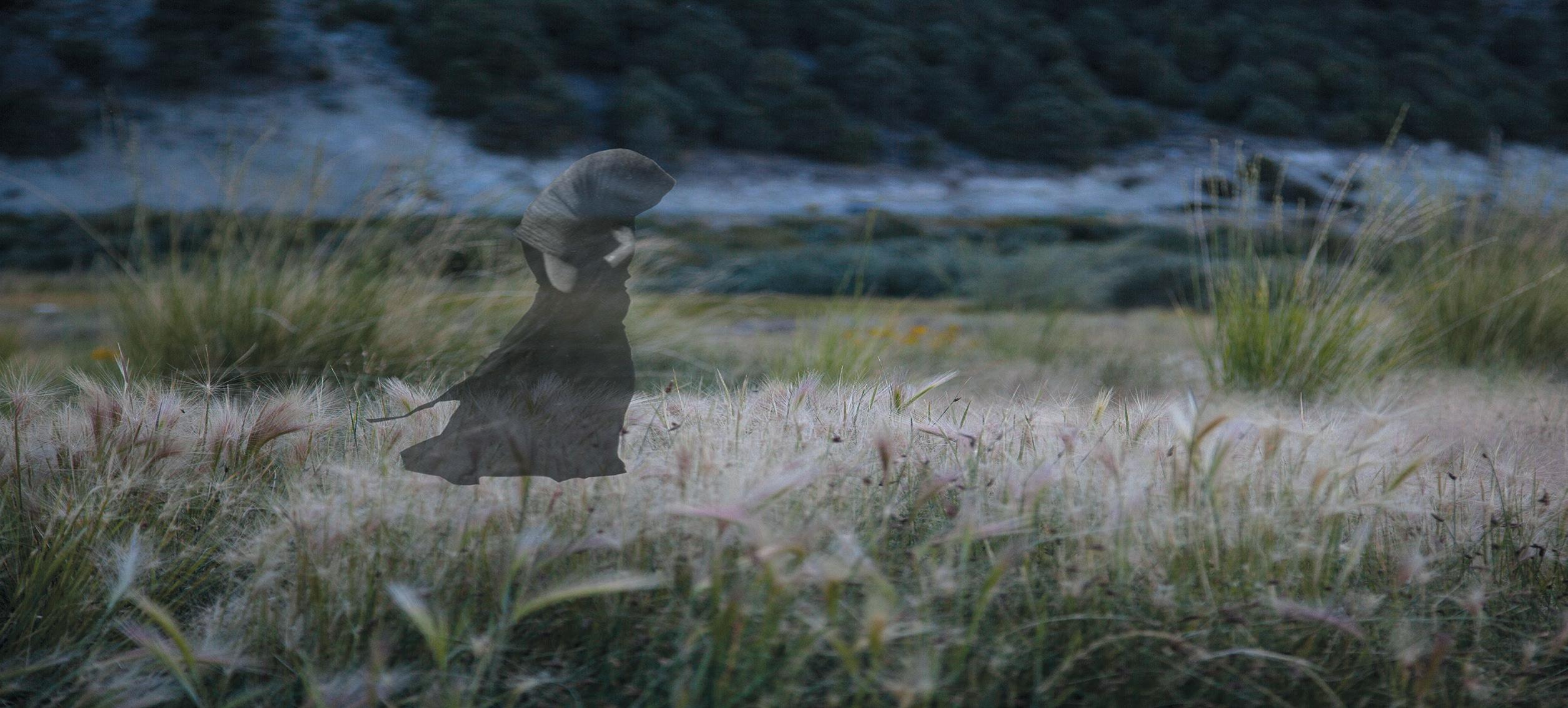 Until science provides answers many of the questions people have about the paranormal will remain unknown.
Boarded up from the outside, this ruined building emanates an eerie light from within.
Until science provides answers many of the questions people have about the paranormal will remain unknown.
Boarded up from the outside, this ruined building emanates an eerie light from within.
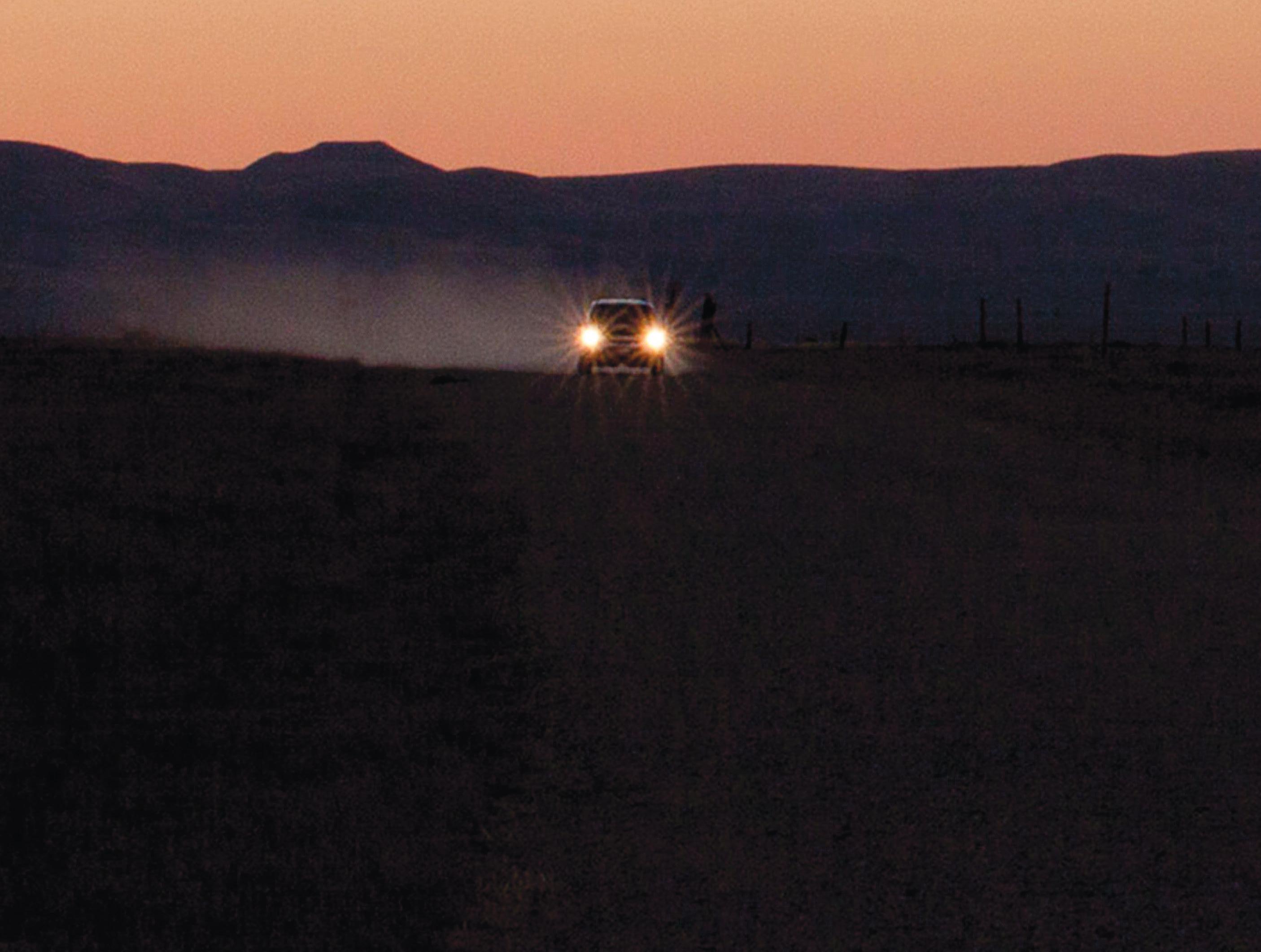
Beyond the limit of overly populated cities and busy highways is a place in California lost in time.
This remote landscape of geographic and historic significance, the Carrizo Plain, is a wilderness untouched by time and real estate developers.
Dusted with sprawling ranches and relics, nestled into rolling hills, Carrizo is reached mostly by unpaved roads that send the traveler back in time, to what California might have looked like hundreds of years ago.
About 130 miles north of Los Angeles near the edges of San Luis Obispo and Kern counties lies California’s largest native grassland area. It is planked by the Temblor Mountain Range to the east and the Caliente Mountain Range to the west.
Soda Lake Road divides the length of the plain and provides the most traveled connection to Interstate 58 to the north and Interstate 166 to the south.
A significant geographical feature of the
Carrizo Plain is the infamous San Andreas Fault that visibly runs along the base of the Temblor Range.
Professor David Chilling, of California State Polytechnic University, Pomona (Cal Poly) said there is no geology book that doesn’t have an aerial photo of the Carrizo Plain. Chilling, is also vice president of “Friends of the Carrizo Plain”.
pointing to the fault. “That’s the San Andreas Fault-you can actually see it, people come from all over the world to see it,” said, Chilling.
“The [San Andreas Fault] is the boundary between the plain tectonics. It’s the boundary between the North American plate that starts off in the Temblors and crosses the way through the middle of the Atlantic. The Pacific plate goes all the way to Japan,” Chilling said.
The San Andreas is an 800-mile continental transform fault, which results as a lateral strike-slip fault.
“You can see a little dark area that comes out of the hills, where the 2 forks join there is a little ridge that goes across the fifth line of clay that runs across the landscape is in the bottom of the hill but about the valley floor,” said Chilling, standing from a vista on the top of Selby Road in the Caliente Mountains
Both plates are going in the same direction, the Pacific plate is moving north six centimeters a year while the North American plate is moving one centimeter a year. Continued movement causes friction and hang-ups from uneven edges causing excess stress, becoming unstuck will result in an earthquake.
In 1857, Fort Tejon had a 7.9 earthquake, the biggest in the Carrizo Plain on record.
A right lateral slip is evident at Wallace Creek. It’s 425-foot “off set” from years of
“There is no [geology] book that doesn’t have an aerial photograph of the Carrizo Plain.”
David Chilling
seismic activity making this ancient section of the San Andreas Fault widely researched by geologists.
In 1988 the Nature Conservancy, U.S. Bureau of Land Management and the California Fish and Game partnered to manage the fragile eco system of the 250,000acre Carrizo Plain. On January 17, 2001, the plain was designated as the ‘Carrizo Plain National Monument,’ which provides federal support.
For the past seven years Johna Hurl, has been manager of the Carrizo Plain National Monument. Hurl’s job was a natural transition growing up on the plain and earning an agriculture degree from Cal-Poly San Luis Obispo.
“When I grew up the Carrizo Plains were called the Carrisa Plains. When the B.L.M. and Fish And Game purchased the land it went back to its historic name Carrizo.”

“We oversee all the different programs,” Hurl said. She coordinates biology and geology along with other research to continue compiling data on the historic plains.
“We have a lot of endangered species out here,” Hurl said. “We have recreation that
happens out here. We have large cultural sights. Native American groups come out here and still use the area from time to time.”
According to the B.L.M., endangered species include California Jewel flower, giant kangaroo rat, San Joaquin kit fox and antelope squirrel, blunt nosed leopard lizard, California condor and recently re-introduced the Tule elk and pronghorn all live on the plain.
Craig Deutsch, historian and author of ‘Another Place & Time: Voices from the Carrisa Plain,’ suggests the first European settlers arrived at the plains around 1850 and flourished until the 1950s.
Evident from the skeletons and hulking shells of old and barns, a great deal of cattle ranchers once inhabited the plains.
In modern times, drought conditions have threatened the livelihood of many ranches still existing. Rich in history, with close-knit community of resilient people, the Carrizo Plains has a breed of folks who don’t live anywhere else.

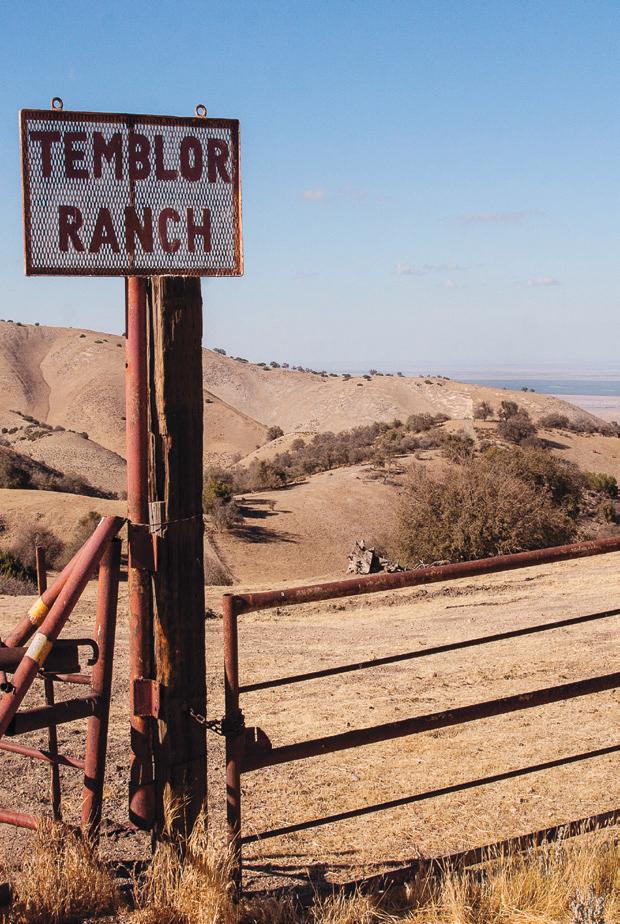
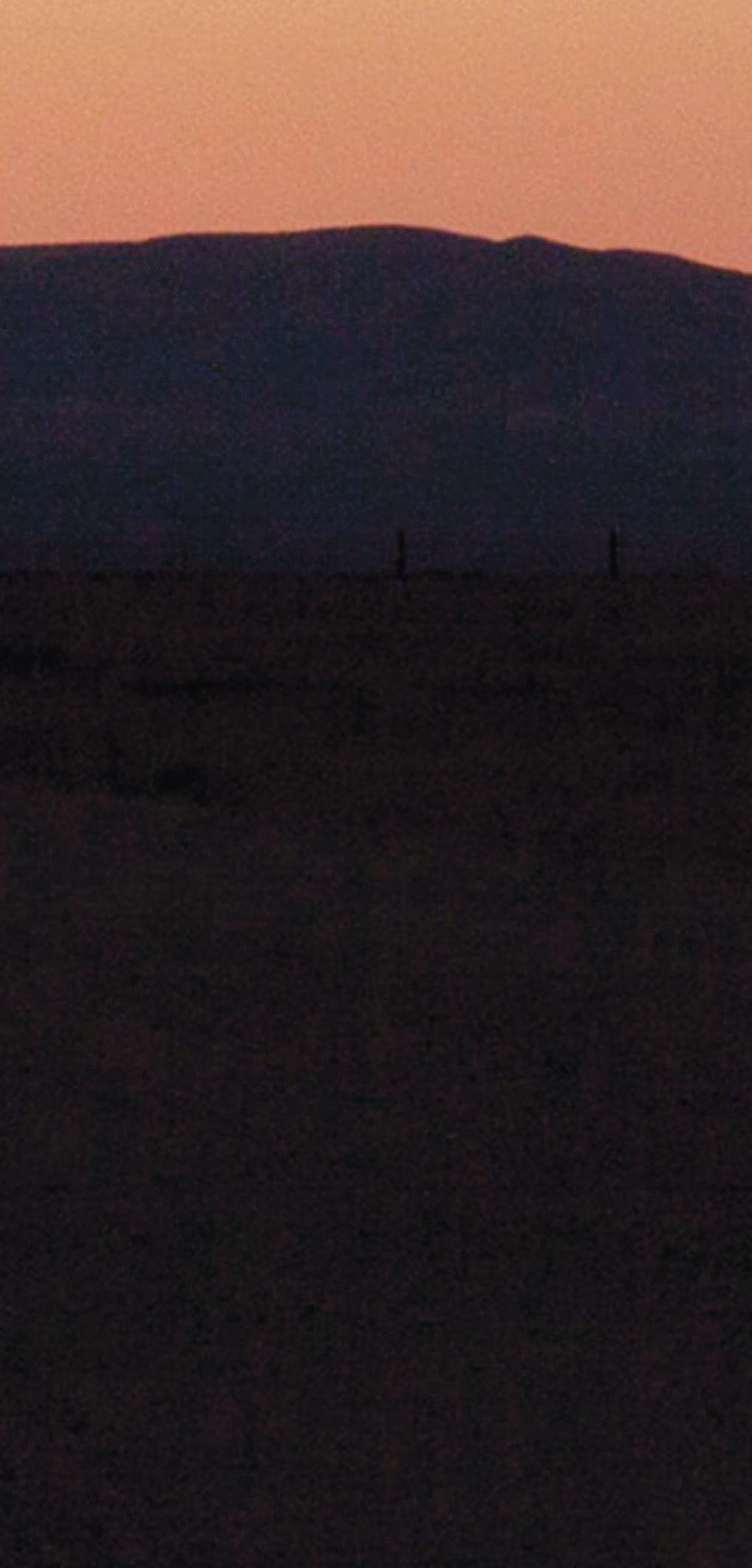

From the little wooden sound box, located to the left of the chute, “Austyn Campbell, you are next on deck,” bellows from the speakers. It is 9 a.m., and the sun has barely began to heat up the day. The nervous impatient woman sits atop her eager gelding just waiting for the alarm to sound and for the gate to open. Her eyes flutter back and forth, staring from the calf to the gate and then forward once more.
The pocket-sized calf anticipates for his rope to break free so he can get a clean runaway. There is a fear and intensity in his eyes as he looks from the horse to the gate and back again. The buzzer thunders and the chute gate flies open signaling for the
rider and her lively stead to exit the cramped quarters of where their drive was caged.
Gravity takes off out the wide open doorway and bolts at the calf. Campbell, lasso in hand, winds back and around again till she has the perfect bend in her rope. Three more clean and concise whips about her head help her to form the ideal noose. Once more she whips the coil of rope around about two feet above her head. When the lasso is in impeccable circumference and Gravity is gaining on the calf she releases her hold of the snare and guides it faultlessly through the air.
Campbell, a rider for the Pierce College Rodeo Team does not spend her weekends like most eighteen year old girls; then again most 18-year-old girls do not spend their Saturday mornings roping calves and making their rounds through a triangle of barrels.
Campball has been riding horses since she was 9 years old, when she became a member of the California Rangers Mounted Drill Team. California Rangers is a non-profit, youth organization that teaches children horsemanship, leadership and discipline.
The California Rangers Eagle Troop that Campbell competed with for four years
competes nationally. They have won many national championship competitions and were No. 1 in the nation for the last four years.
“I have always loved horses ever since I was little,” Campbell hollered over her shoulder as she swung her leg over her horses’ back and planted her seat in the saddle. “But it wasn’t until my sister joined California Rangers that I got involved with actually riding them.”
Campbell reminisced about her time in the California Rangers and explained, “Rangers taught me respect, responsibility, leadership and how to be a good teammate.”
Campbell knew rodeo was her dream, when “For my 17th birthday my sister and brother got me a roping lesson as a present, I fell in love.”
That one roping lesson was what convinced Campbell that rodeo was what she wanted to do.
“When I heard I had a chance to do high school rodeo I knew I had to take it, I loved Rangers but it was time for a change and it was time for a new chapter in my life and in my riding. I was really just looking for something to push me outside my comfort zone,” she said.
Meanwhile, back at the rodeo, the rope
Austyn Campbell on her dapple grey, Gravity, running poles during a rodeo in Filmore, Calif.flies through the air straight for the calf, the audience stares in apprehension, wondering if Campbell caught her runaway and Campbell, with a look of hope and fear, watches as the rope catches up with the speedy and agile animal.
“Riding a horse in general can be difficult because you are trying to connect with a 1,000-pound animal,” Campbell said while her horse dances around waiting to go into the next event. “But in rodeo, especially team roping, you have five completely different minds trying to achieve different goals. The steer is trying to get away from you. Your horse is trying to please you. Your partner is trying to catch one end while you are trying to catch the other and accomplish all of this in under 10 seconds in order to place.”
All of those things are contributing factors of whether or not Campbell and her roping partner, Meg McNamara, will even place, which can put a lot of stress on them.
“There have been multiple occasions where Campbell and I could have gotten hurt,” McNamara said. “In team roping, there are three animals to control and all of these animals are unpredictable.”
Campbell recalls this happening in the past. “One practice day at Eagles we were going through a cross and two girls collided, resulting in one of them dropping the flag they were carrying,” she said. “That caused my horse to spook and rear up and hit me in the face, I had a minor concussion, a fractured nose and a deviated septum. I had to have two surgeries because of it.”
Cheyenne Davenport, one of Campbell’s former teammates from Eagles witnessed the incident when Campbell was injured.
“The day Campbell broke her nose was ridiculous. Earlier that day a man fatally crashed his motorcycle just outside of our practice arena,” Davenport said. “We saw it happen, which was already traumatizing. Just after that Campbell broke her nose. We couldn’t believe all the bad things after practice. We ended practice right after she left for the hospital.”
These inquiries happen everyday in the horse industry. According to riders4helmets. com, approximately 78,000 people were injured in 2007 in equine-related incidents. Those statistics do not stop Campbell or thousands of other women who experience the same feeling of adrenaline when they step into an arena.
There are more difficulties in rodeo than just the injuries.
“At one of the first rodeos, I caught my horse’s tail, and Austyn roped her horse’s front
feet. Ropes and horses do not always go well together,” McNamara explained.
In the meantime, back in the arena, just as the calf lifts his head in a show of arrogant success, the lasso falls gracefully about his neck and traps him, securing his place cinched to her saddle. Gravity slams on the breaks and Campbell sits firmly in her saddle waiting for the rope to break free.
“Campbell has taught me to always be the best teammate you can be, because no matter what is going on in your life it’s never enough
to be an excuse to let your team down,” said Davenport, who was Campbell’s teammate for four years.
Campbell shared her first rodeo horse KC, the teammate that has had the greatest impact.
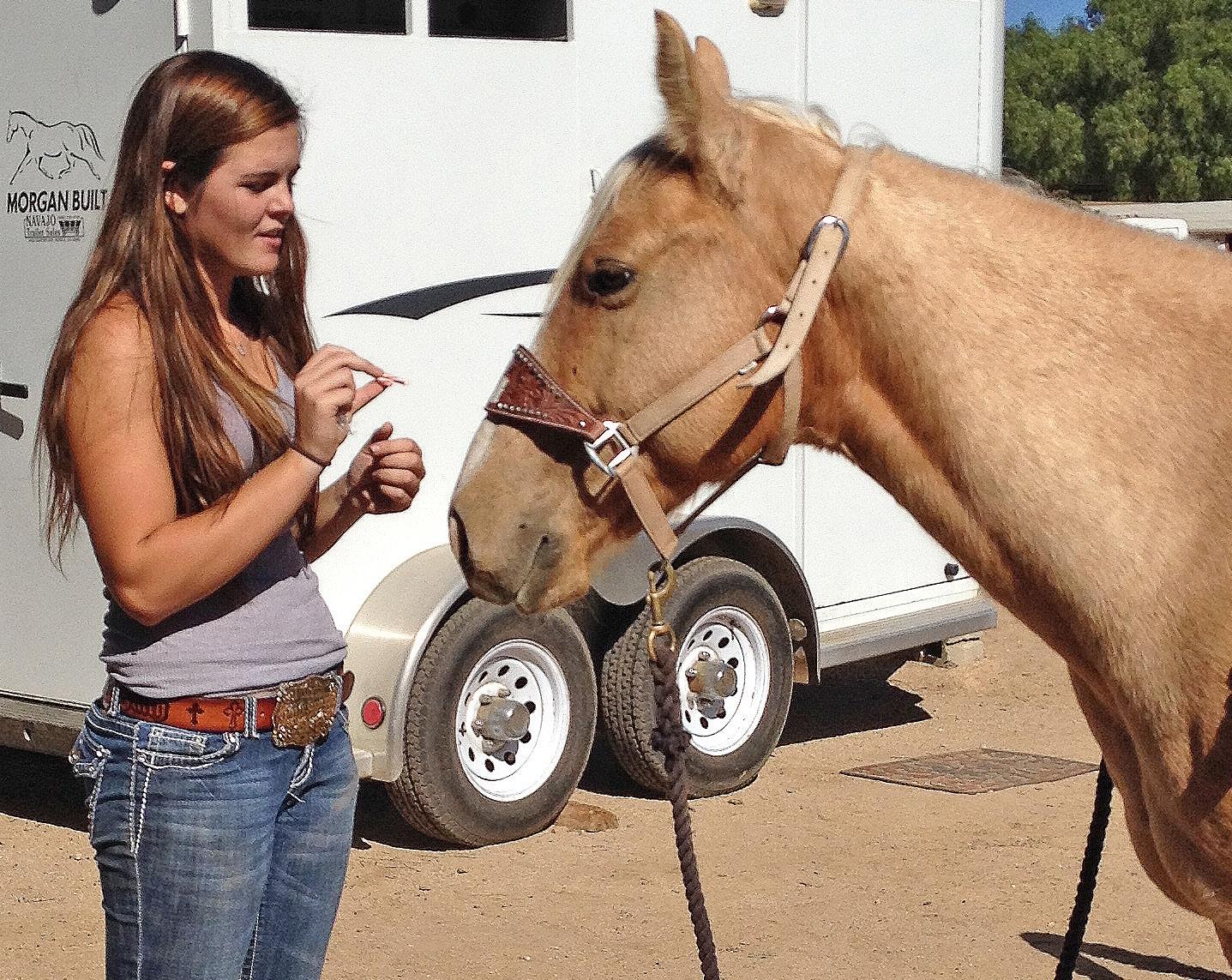
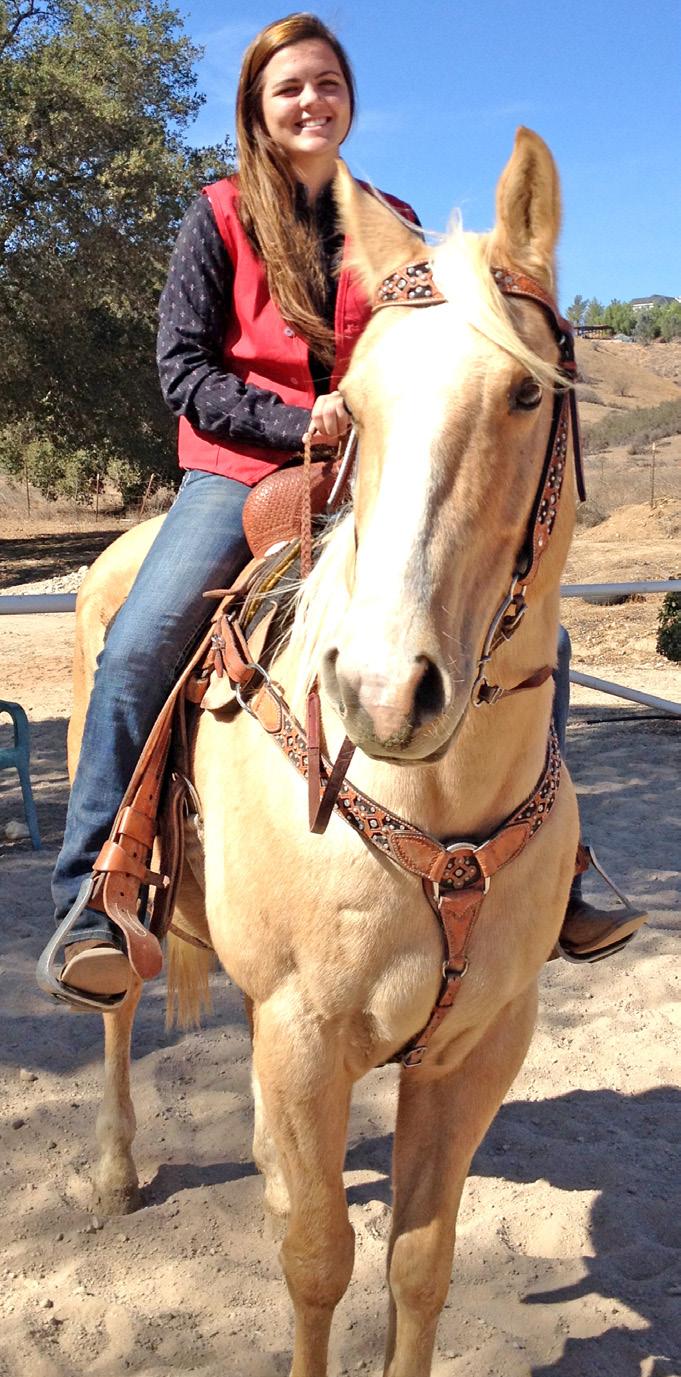
“He taught me more things about myself and riding than I could ever imagine. He was definitely a little spitfire,” Campbell said as she reminisces about her lost friend. “My first time ever getting on him he would not stop rearing, I did not trust that he would ever be able to
calm down, but to my amazement he ended up being my all around horse and I won a lot of events on him.”
Campbell on her four-year-old Palomino, Dually at The Perez Ranch in Castaic,Calif.“KC taught me to have patience, he showed me the way and gave me the confidence I needed to continue.”
Austyn Campbell
Top:


Walking through the door that leads to the holding pens of the shelter, as if on cue, the incessant barking of various breeds of dogs waiting to be adopted fills the outside area, silencing the otherwise comforting noise of the mist machines keeping the animals cool on a hot summer afternoon.
No Kill Los Angeles (NKLA), a coalition consisting of Best Friends Animal Society and 71 other animal welfare organizations, seeks to end the killing of healthy pets by a program with an emphasis on adoption and the spaying and neutering of pets. In its first year of operation in 2012, more than 4,000 fewer animals were euthanized than the year before, and NKLA helped in the adoptions of more than 23,000 animals according, to the organization’s website.
Powered by the help of volunteers and donations from individuals and grants, NKLA is set on making its goal of making Los Angeles a “nokill” city by 2017. To volunteer, donate or adopt a pet, visit their website at www.nkla.org.
 Story and Photos by: Mohammad Djauhari
Story and Photos by: Mohammad Djauhari
ats and kittens stroll leisurely through the spacious kennels. Rosemary, a black shorthaired, plays with her sister Sage from atop a cat tree. Across the narrow hall, twin tuxedo kittens paw hysterically at a feather toy that hangs suspended from the ceiling. Eight others soon join in on the fun. Watching from the other side of the gated playroom is Debbie Regal, founder of Petopia Animal Rescue and resident “den mother.”
“I didn’t know anything about keeping a pet. But you learn a few things after a little while,” Regal said.
Staffed by volunteers, Petopia Animal Rescue, founded by Valley Cats Inc., is the second of two establishments founded by Regal.
Opening in November 2012, it has been a glimmer of hope for countless pets that were relinquished by their owners to the pound or saved from hoarders. Yet few know what happens behind the scenes.
“We face the issues that any animal rescue does. Rather than trying to work out the problems people seem to think that we [rescuers] are here to handle their overload,” Regal said.
This theme is not uncommon. It is almost three million that are “put down” every 11 seconds in America alone. They are often the offspring of family pets that have not been spayed or neutered. The ASPCA has five to seven million animals living in shelters, of
which 60 to 70 percent will be euthanized. Most are brought back to the shelters by the same owners who adopted them. After rescuing cats for 40-plus years Regal has seen and done it all.
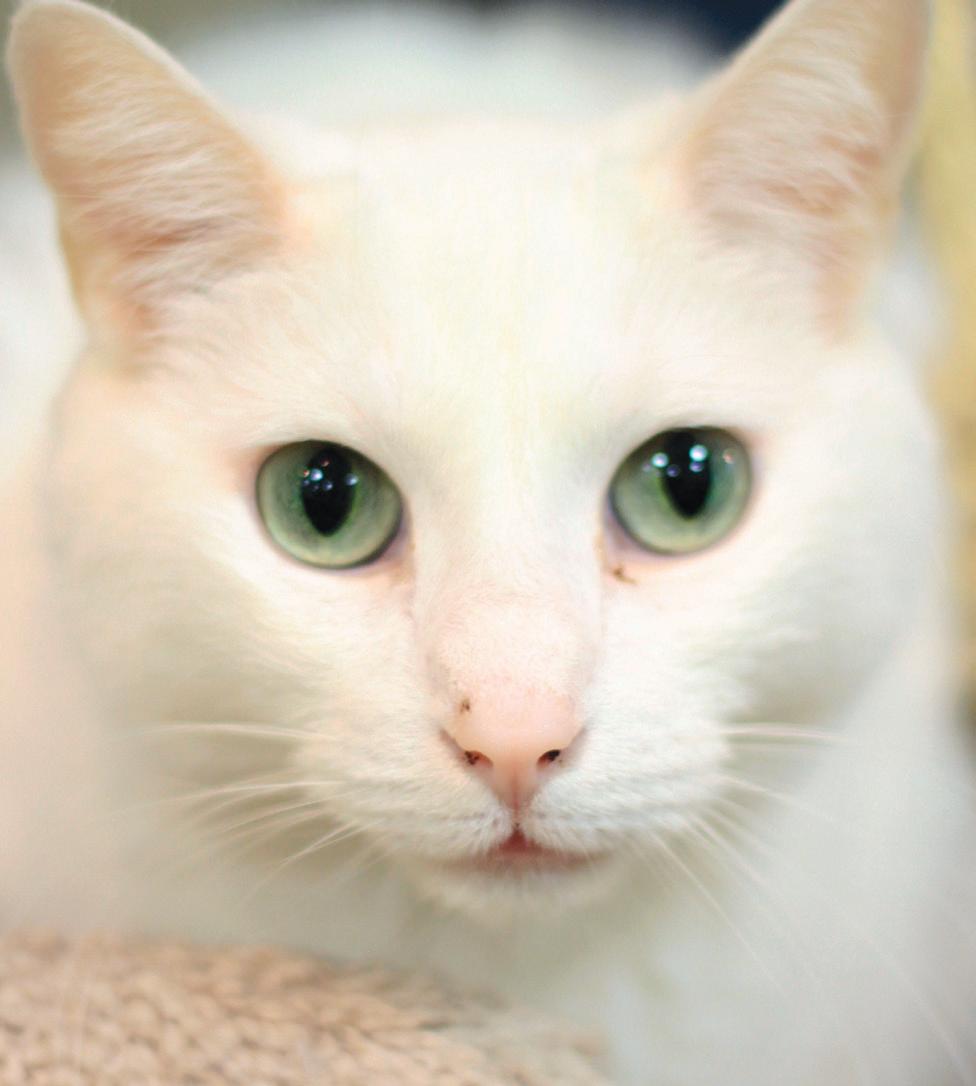
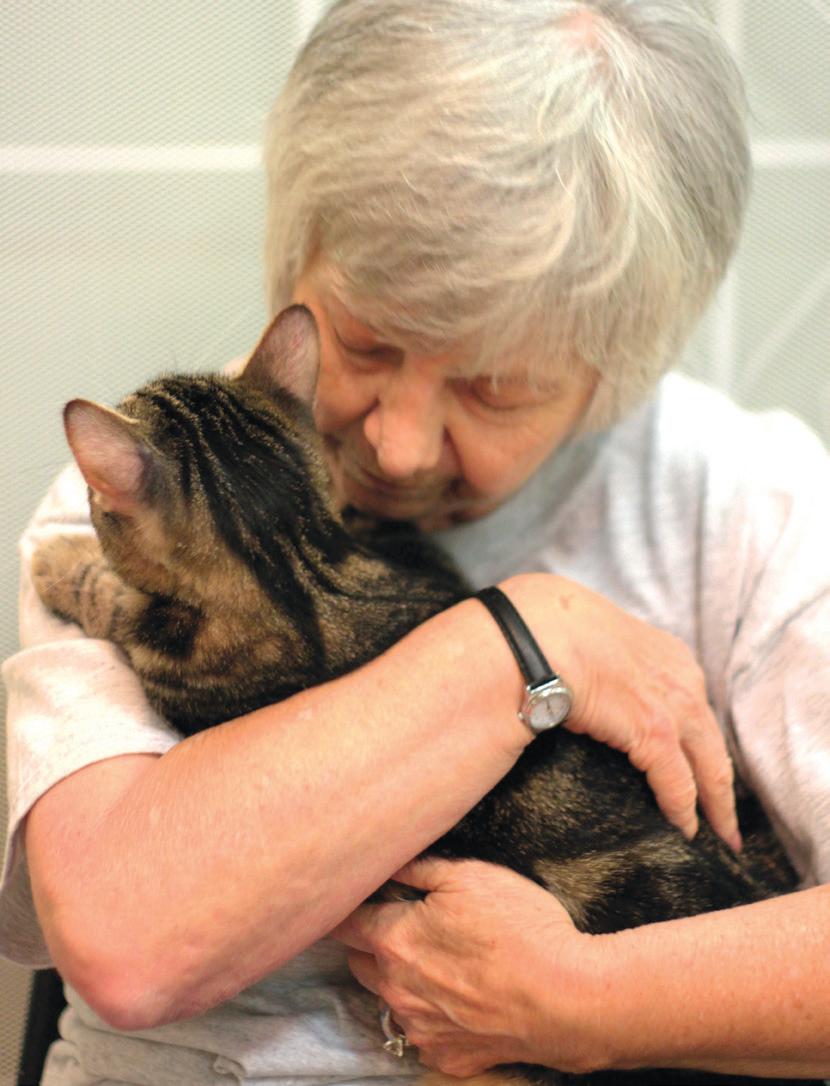
With a lifetime of experience under her belt, Regal compared what it is like rescuing from a hoarder, as opposed to the pound.
“In that instant you can probably rescue all of those animals [from a hoarder]. Some of them make it. Some of them don’t because of the conditions,” Regal said. “But at least you will have tried. But when you go to a shelter there’s no way on earth you can take them all. And the heartbreak is that you cannot save them all. So you do what you can.”
The road to recovery after a rescue does not end with filling out release forms. All of the cats Regal brings back are de-wormed, spayed or neutered and screened for AIDS and leukemia. The cats are micro chipped before being released for socializing. Assisting in the efforts are the enthusiastic volunteers.
Kimmia Moarefi, 16, has only recently joined Petopia. Although she has never had a cat, Moarefi is the proud owner of two dogs.
For her, Petopia is more than just a place she volunteers, it’s her place of work. And like any job it too has its difficulties.
“I don’t like it when people come in here and think this is a joke. This isn’t a zoo,” Moarefi said. “It’s hard to tell who actually wants to adopt.”
Personally overseeing the adoption process, Regal screens all prospective owners using the questionnaire they must fill out before entering a playroom. When the last of the paperwork is signed the animal is turned over to its new owner. However, cats are not the only pets up for adoption at Petopia.
The Southern California Pomeranian Rescue founded by Leesa Molina shares space with Petopia. The Santa Barbara native opened shop soon after relocating.
After a sudden spur of growth, Molina was looking for a place and she read in a magazine that Petopia would be opening.
“I called and apparently they had worked with one of our volunteers a few years ago and really liked her. We’ve been able to place a lot of dogs here,” Molina said.
In the beginning, Regal worked as a teacher to Special Needs students K-12 in the Chicago inner city. Now Regal’s hobby has become a mission and it all began with a cat called Taffy who followed her home one Halloween night.
“After that I was in like Flynn,” Regal said. “I mean I just couldn’t stop. I couldn’t stop rescuing.”
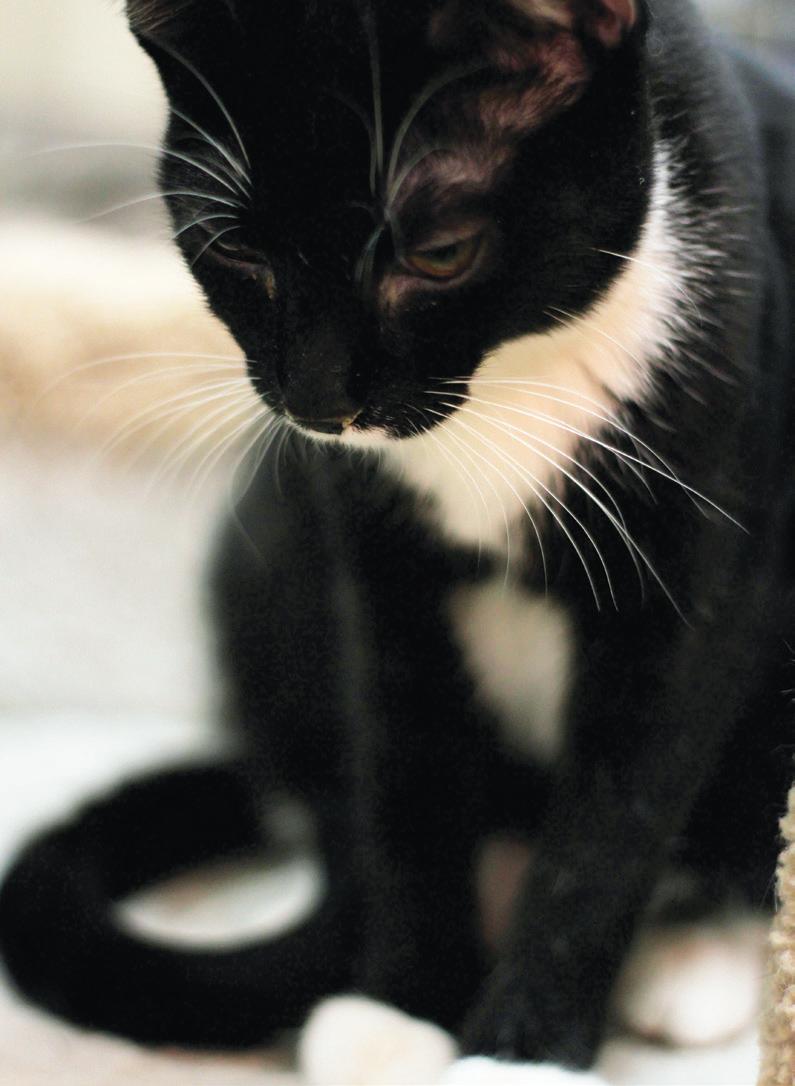
“Some of them make it. Some of them don’t.”
Themed restaurants bring the concept of combining design with food and taking people somewhere else. It’s a new way to travel without leaving the city. New adventures and experiences await with unique food and diverse cultures.
A bright red-and-white room, candy-striped uniforms. The feel of old America, having a milkshake with French fries.

One themed restaurant is Ruby’s Diner, and in it, the 1940s have never been closer.
The first restaurant opened in 1982 and soon took off. The owners found a warehouse in Balboa Pier that was modeled in the 1940s. They decided to run with it, and so came Ruby’s Diner.
The diner is decorated in bright red booths and white tables and walls. A jukebox near the wall and 1940s poster art decorate the restaurant.
Mike Kovacs, manager of Ruby’s Diner in Woodland Hills, said that the 1940s theme reminds people of simpler times.
“It’s the sense of nostalgia,” Kovacs said. “The war ended and people [were] coming home. It was just a happier time.”
Themes in restaurants create a different environment for people and take them out of everyday life.

“It’s like an escape for people,” Kovacs said. Merrill Shindler, a food critic for Zagat, said that some themes are different and hard to describe, but that’s what makes the dining experience more enjoyable.
“It’s a little hard to say what a theme really is because you know the theme for most restaurants is ‘we serve you food,’” Shindler said. “There are themes that are downright theatrical. You know those definitely were heavy duty themes. But then you have more intregrated themes. Some of the stranger themes actually are found in Asian communities. Apparently Taiwan in Taipei is an unbelievable hot bed of themed restaurants.
Daron Ellezer, a waiter, serves fries and a milkshake at Ruby’s Diner, Woodland Hills.There’s a restaurant that has you pretend that you’re in jail, where you sit inside a cell and the food is slipped in on metal plates. Another restaurant where you literally sit on toilets and are served food in miniature toilets.”
A dark room with dull lights glowing in the corners. Dusty, old coffins crawling with spider webs, wine racks lining the wall. Chandeliers hanging from the ceiling, cobwebs dangling everywhere. Another themed restaurant is The Stinking Rose, where the owner knows everything there is to know about garlic. They have garlic food, art, drinks and ice cream. The restaurant has six rooms decorated in different styles. They not only have a Dracula room, but
of The Stinking Rose in Beverly Hills. Marmorino said the key to success with a themed eateries is balancing the theme with the food.
“It’s good ingredients, quality ingredients,” Marmorino said. “There is no other restaurant in this town [like ours].”
Garlic may not be for everyone but The Stinking Rose knows how to make it into a theme. The food isn’t gourmet but the restaurants are well known for incorporating garlic into their dishes without overpowering them, Marmorino said. The restaurant is as unique as its name.
“A lot of it comes down to the food. You know, I noticed that at quite a few of the restaurants, no one really spent very much time trying to create food that was edible,” Shindler said. “It was like if we create a zany enough theme everyone will just come on by. Ultimately, after a while, you stop looking around. You stop looking at the guitar that Keith Richards once played and you want to get down to the ribs on the plate. So it wasn’t just the theme; it was also good food.”
in the same city, due to the idea of themed restaurants.
The Bleecker Street in Tarzana is serving up food Manhattan-style. A New York night on a lit balcony with great food and great people right here in the valley. Brick walls surrounding the restaurant give it an authentic feel.
“You get a different flare in the food, a different variety. It gives [people] a really nice feel,” said Katie Kisiel, owner of the Bleecker Street.
The look of a theme may be important for restaurants to succeed but so is the cost and taste of the food they serve.
Shindler believes some restaurants incorporate the theme of their restaurant better than others.
“I always thought Hard Rock did a good job of it. I’ve always enjoyed the Chinese themes,” Shindler said.
Shindler agrees with Kisiel on her view of themed restaurants. They both think that the food of the restaurant is very important.
The first The Stinking Rose restaurant opened in 1995. They have a Californian Italian influence in the food. It started with the garlic lover’s club and developed from there, according to Massimo Marmorino, manager

A balcony overlooking a view. Lights shining, rustic brick walls. Crowded space, people cramped together. All these different times, place, and cultures can all be found
“Themed restaurants, they are entertaining if a little or a lot peculiar,” Shindler said. “So if they succeed it’s probably because after a while you want to go back because you ate good.”
Wine bottles and garlic bulbs hang from the ceiling in a room at the Stinking Rose“It’s like an escape for people.”
Mike KovacsStory by: Angel Bocanegra Photos by: Lynn Levitt
Winnetka 21.
An XME theater is with Dolby Meyer Sound experience and twin projectors that share the same technology as Star Tours at Disneyland. It brings a new meaning to movie-going.
“There’s no difference. The difference is in the set up of the projector,” Westberg said.
Despite a fresh coat of paint, Pacific Theatres Winnetka 21 in Chatsworth seems old from the outside. Inside, employees smile and sell outrageously-priced tickets and popcorn, which beckons customers with its freshly-popped, buttery smell.
Walking down the aisles of the theater, the smell of leather from the seats lingers in the air. But the real showstopper is the 79-foot tall screen, which is waiting to whisk guests away from the reality of their lives and into a world of fantasy — thanks to Extreme Movie Experience (XME).

The XME has an at-home feel, with the new leather seats that are stylish, comfortable and spacious; they are about the size of one and half of the regular seats, so those who are a little large fit without ending up banging elbows with the person next to them.
“With such a nice theater, might as well add nice comfortable seats for the guest,” said Nora Delgado, point person accountable of the theater.
Movie technology started with light shining through a frame. Then, motion was added. A recent significant change came in 2005, when digital projectors were introduced to cinemas. Now there’s digital, High Frame Rate, Image Maximum (IMAX) and the 4DX, which will soon debut in Los Angeles.
But, until 4DX comes, the San Fernando Valley can settle for XME at Pacific Theatres

The 3D is more pronounced due to each lens of the glasses connecting to its own
An IMAX projector requires two stories where the 80-millimeter-wide film bounces and uses gravity to reach the top of the projector, while the XME theater is in complete digital. IMAX is also a brand that has exclusively partners with AMC Theaters and Regal Cinemas.
IMAX also has the upper hand when it comes to using the large screens to full capacity because most IMAX films are filmed with special IMAX cameras. Additionally, XME theaters cannot use the full 79-foot screen, and adaptions to compensate can be costly.
“The current lens limits the screen area utilized. Each lens to correct this costs $25,000,” Westberg said.
projector and causing a deeper dimension for 3D, according to Steve Westberg, head charge of all projectors for Pacific Theatres and ArcLight Cinemas.
Some wonder if the price is worth the experience, but others come away in awe.
“The 3D was amazing,” said University of California Riverside student Henry Marshall, who watched “Gravity” in 3D with a couple of friends. “The huge screen made me feel as if I was in space.”
The fuller and better sound quality does come at a price; at the Pacific Theatres Winnetka, it will be an extra $3.50 for the XME theater for a 2D film or a 3D film in a normal theater, and $5 for XME in 3D.
So, what’s the difference between IMAX — something familiar that is seen and heard on TV, radio commercials and posters — and
Those seeking even more of a thrill will have to wait for the new 4DX theaters coming soon.
CJ4DX is a new Korean technology company that has brought the 4D experiences from Universal Studios and Disneyland short five to ten minute experiences to featurelength films.
“The system is designed to put audiences into a film’s environment with motion, wind, fog, lighting and scent-based effects,” The Hollywood Reporter’s Carolyn Giardina said.
In her article, “CinemaCon: 4DX Targeting U.S. Market,” she goes further in detail about plans to expand theaters in Los Angeles and Miami, and how the cost is going to be roughly $8 more than the cost of the average ticket price.
With new theater experiences being created everyday, take a look at what’s close to youThe torazo lights up the night sky, at the Pacific Theaters in Northridge, Calif.
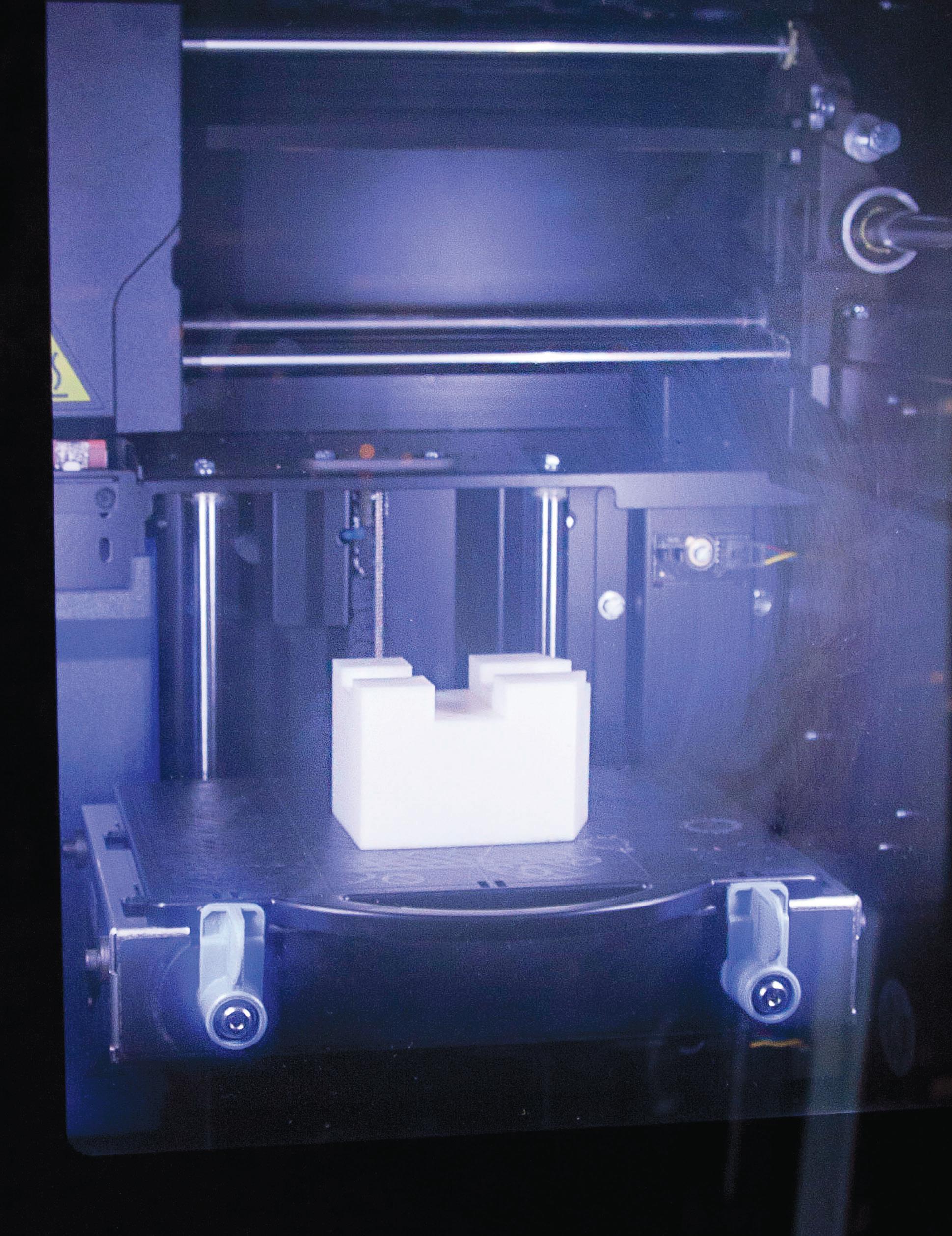
Located in the Applied Technology building at Pierce College a 3D printer sits in Assistant Professor Elizabeth Cheung’s room. The lights above the printer give it a glow of attraction.
Cheung, holding a jet-black 8-by-8 plastic tray, pulled open the translucent door and placed the tray in the printer. She pressed Start and the tray began to move
back and forth, left to right.
“It’s just checking to make sure it’s completely flat,” Cheung said.
The rapid movement of the tray stayed consistent for about five minutes. Then it sat still. After 30 seconds the ink above the tray began to dispense, building from the ground up at a slow pace. It took almost two hours, but the printer fabricated a 6-inch plastic wrench that is fully working.
The 3D printer, clearly, is a major step in technology.
“The sky is the limit from now on with technology,” Cheung said.
Being able to print 3D objects is a new beginning, and someday food may be added to wrenches plastic figurines. This is a major step in business because a 3D printer can be used for a variety of prototypes.
Story by: Maddie BernieBefore actually using the printer, pepole create their 3D objects with software called Computer-Aided Design. The software sends the file to the printer. When the 3D printer is on, the rapid movement deposits the plastic material called Acrylonitrile Butadiene Styrene (ABS). It dispenses a .003 inch thick layer of ABS when being dispensed.
“It can take as long as it needs. A 6-inch object could take two hours,” Cheung said, depending on the objects size.
John Pitstick of the online advertisement company ValueClick owns a 3D printer. He is one of a few people that have a printer in their house, given its cost.
“The ABS plastic is $4.50 per cubic inch. That doesn’t sound a lot, but it definitely adds up,” Pitstick said.
One of his favorite prototypes he designed is a toy car.
“I know it doesn’t exactly look like a toy car you would buy for your kid at Toys ‘R’ Us, but it’s pretty amazing a printer could do this,” Pitstick said with a smile.
“The future is in the hands of the 3D printer,” according to Dave Smith, one of Pitstick’s friends. Loving the idea of the 3D printer, Smith wanted to learn its every aspect. His love for the printer made him research it inside out.
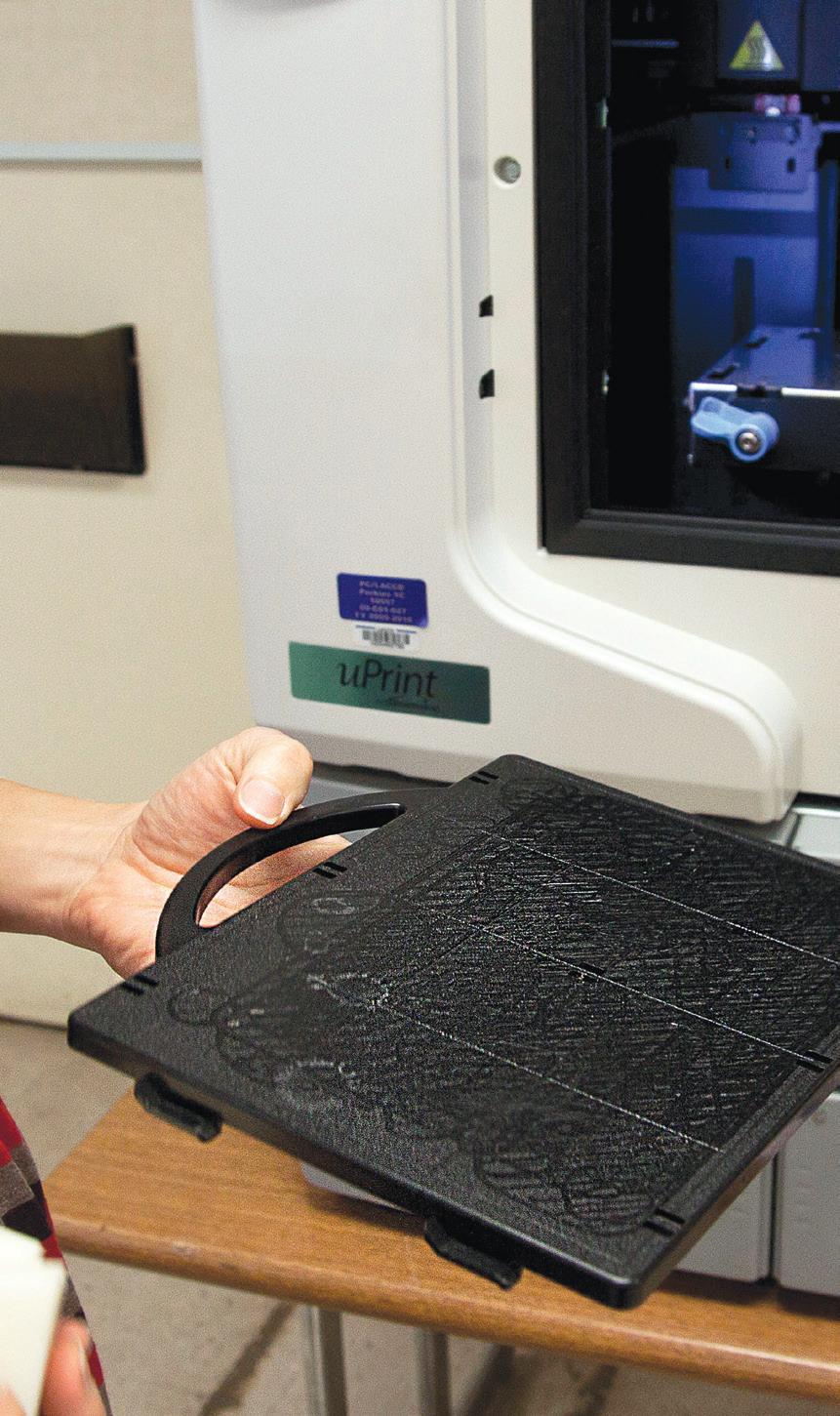
“The ability to print food would be a great advantage to our world today,” Smith said.

“I think it’s a fantastic idea, very furturistic.” Smith said.
NASA might agree with Smith. According to DailyTech.com, NASA gave $125,000 to be able to print 3D pizzas in space. This is a major eye-opener to what is possible.
Pitstick, on the other hand, had a different opinion.
“I think printing food is so strange, I’d rather eat a hamburger off a grill then off a printer,” he said.
Even though everyone has their own opinion on the 3D food, it is amazing that scientists have the ability to do it.
“It’s so amazing that this printer can put so much detail into a 3D prototype. It really blew my mind the first time I saw the printer in action,” Pitstick said. To many, the 3D printer is an amazing step in technology.
Being able to fabricate 3D objects in this day and age really makes one wonder, what could be next?
“The sky is the limit from now on with technology.”Cheung, (not pictured) holding a plastic tray, explains this is where the ink deposits on.
